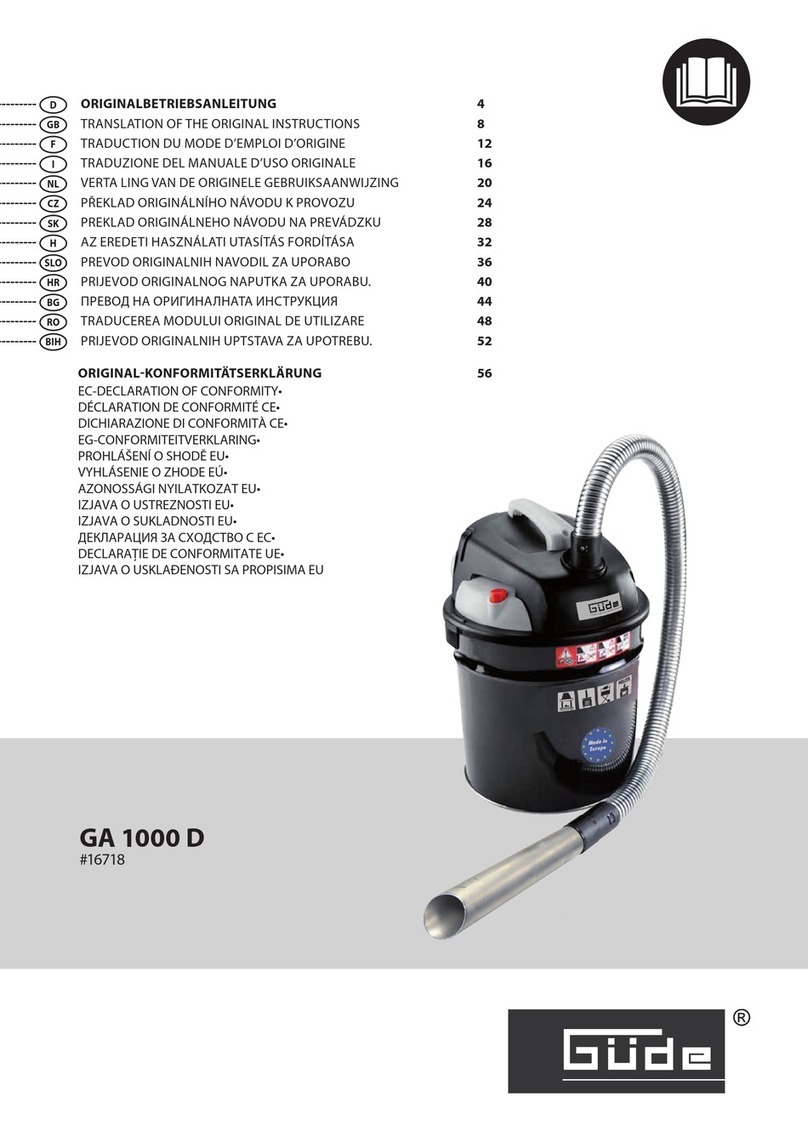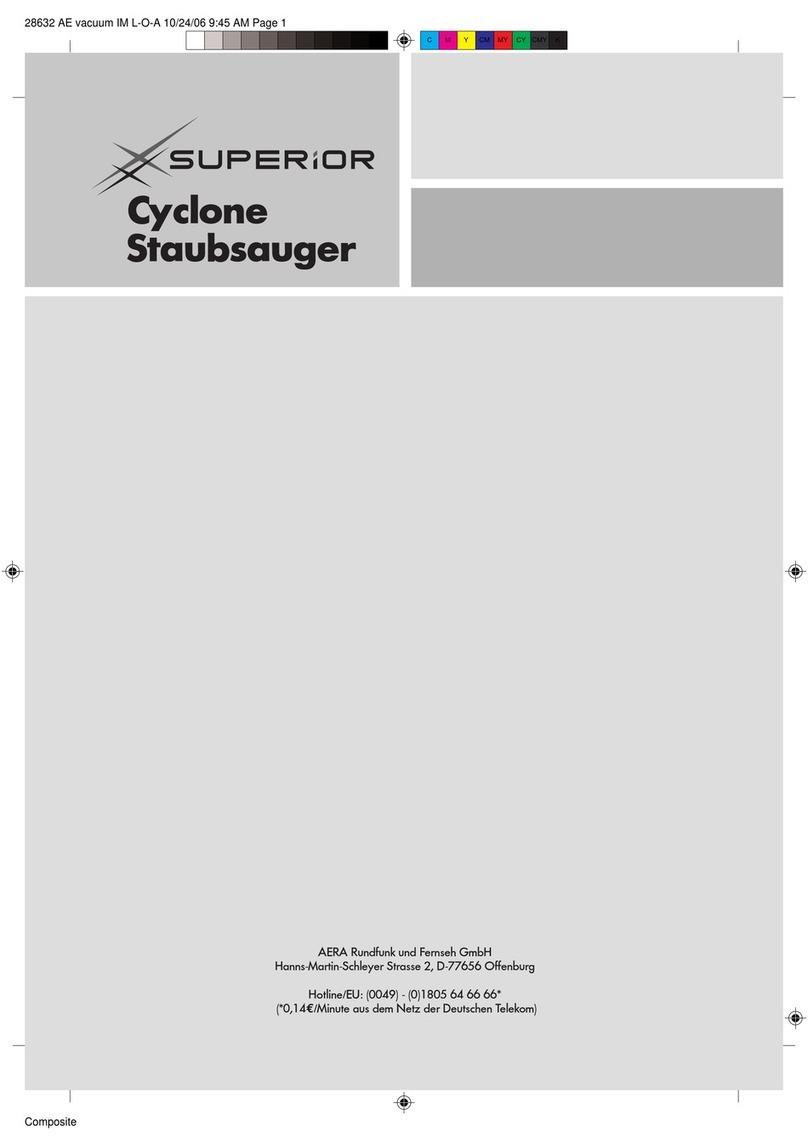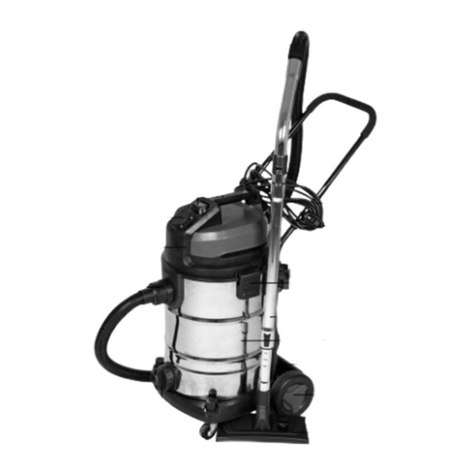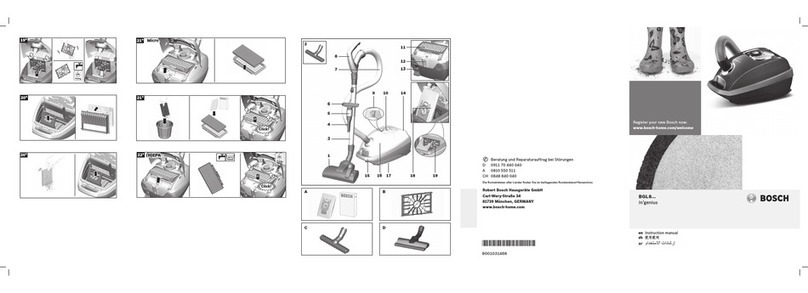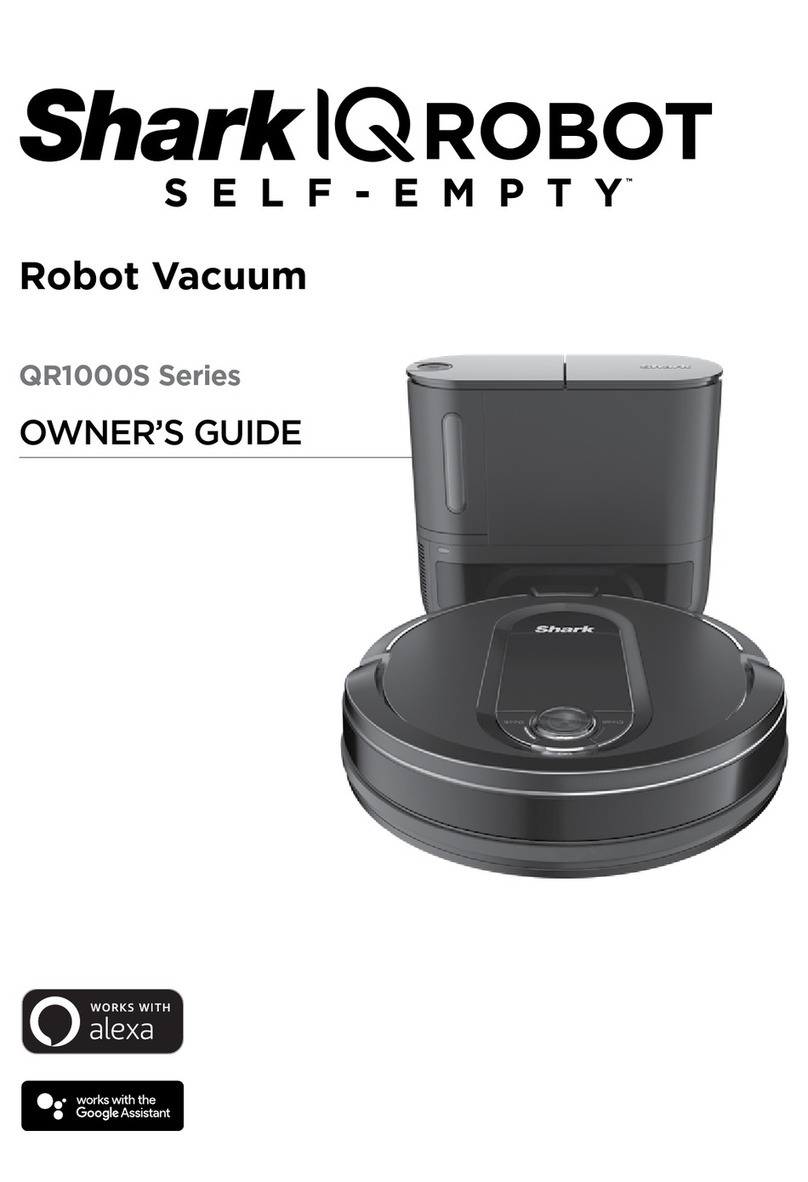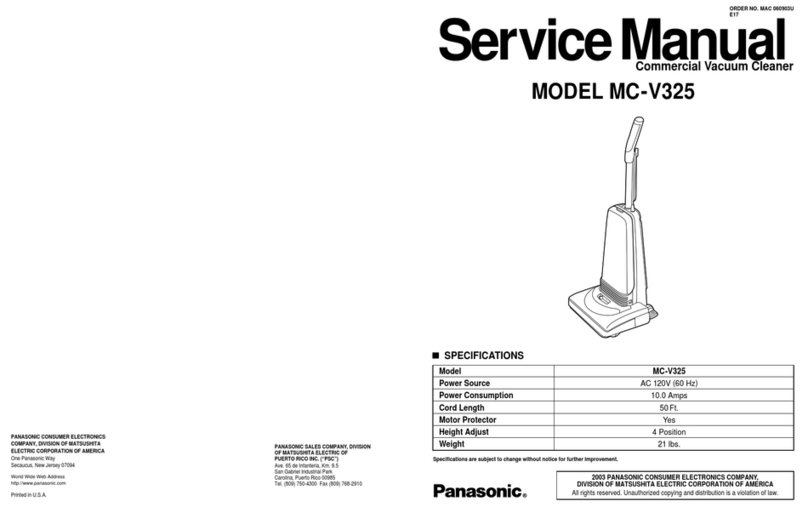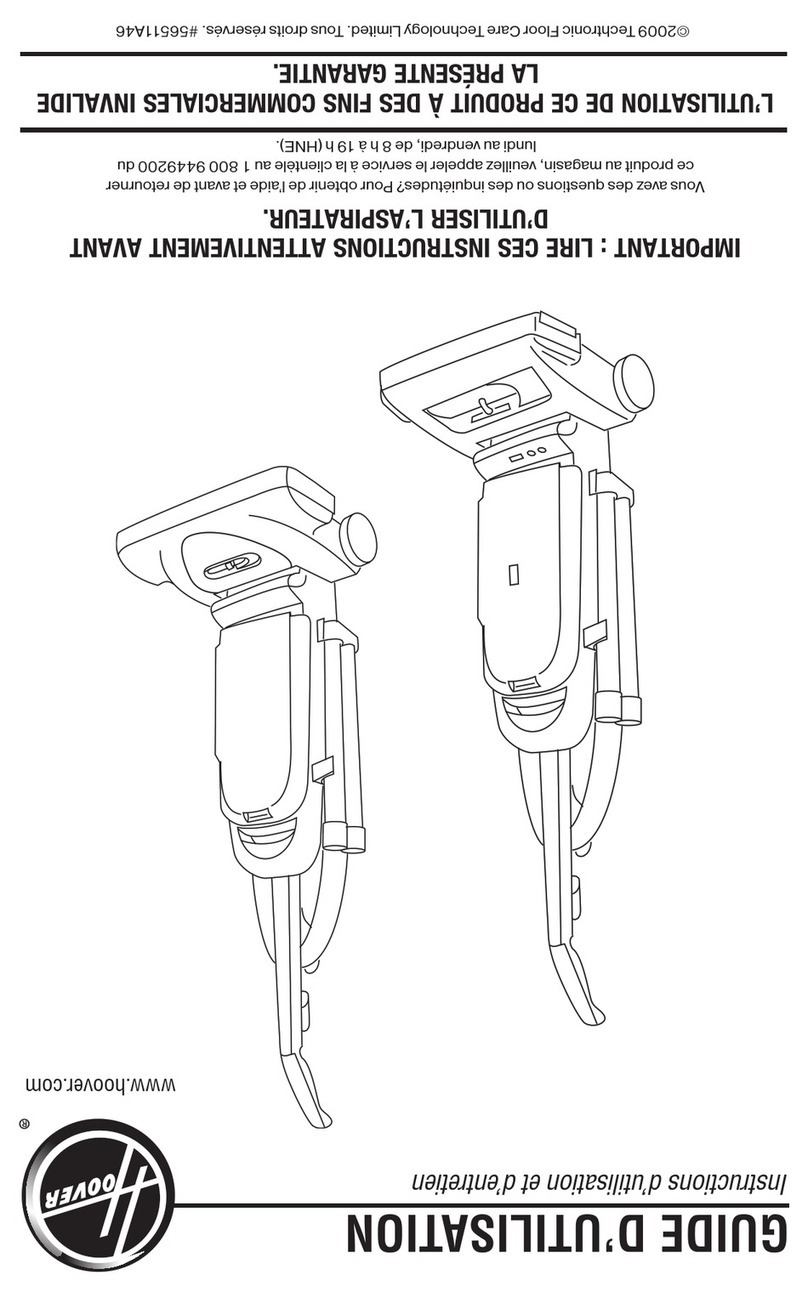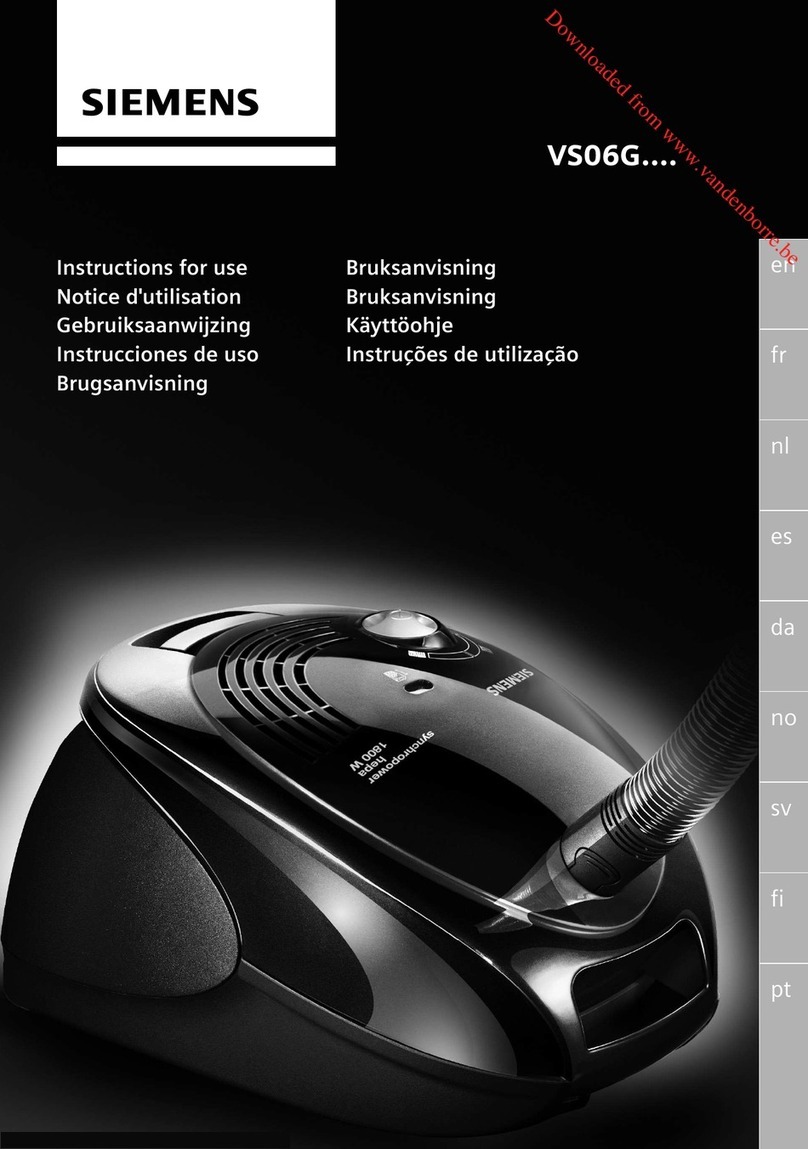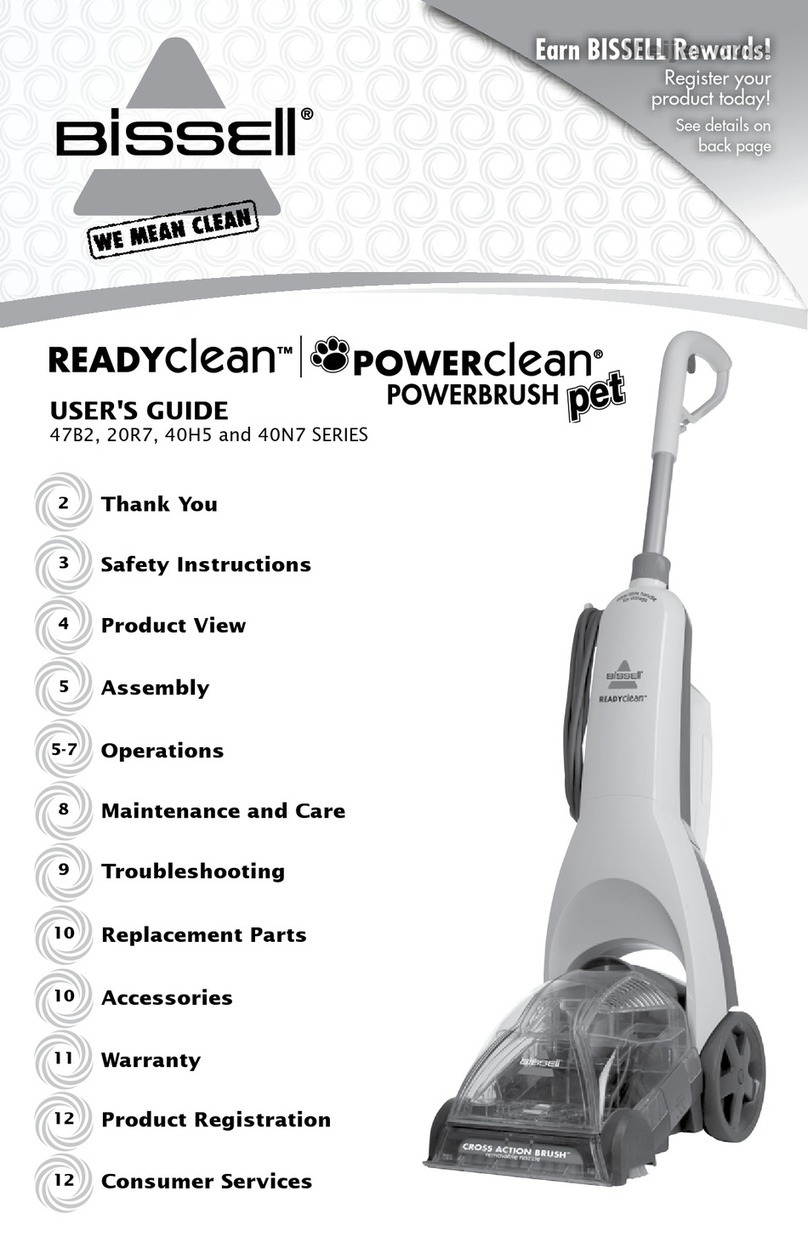Gude NTS 1200 Wiring diagram

NTS 1200
#16713
©Güde GmbH & Co. KG - Birkichstrasse 6 - D-74549 Wolpertshausen - Deutschland
Deutsch D 4
Originalbetriebsanleitung
NASS- UND TROCKENSAUGER
English GB 8
Translation of original Operating Instructions
WET/DRY VACUUM CLEANER
Français F 12
Traduction du mode d’emploi original
ASPIRATEUR EAU ET POUSSIÈRE
Čeština CZ 16
Překlad originálního návodu k obsluze
VYSAVAČPRO MOKRÉ A SUCHÉ VYSÁVÁNÍ
Slovenčina SK 20
Preklad originálneho návodu na obsluhu
VYSÁVAČNA MOKRÉ A SUCHÉ VYSÁVANIE
Nederlands NL 24
Vertaling van de originele gebruiksaanwijzing
NAT- EN DROOGZUIGER
Italiano IT 28
Traduzione del Manuale d’Uso originale
ASPIRAPOLVERE AD ASPIRAZIONE UMIDA E
SECCA
Magyar H 32
Eredeti használati útmutató forditása
VIZES ÉS SZÁRAZ SZIVÁSÚ PORSZIVÓ
Slovenščina SLO 36
Prevod originalnih navodil za uporabo
SESALEC ZA MOKRO IN SUHO SESANJE
Hrvatski HR 40
Prijevod originalnih uputa za korištenje.
USISIVAČZA SUHO I MOKRO USISAVANJE
Bošnjački BIH 44
Prijevod originalnih uputstava za korištenje.
USISIVAČZA SUHO I MOKRO USISAVANJE
Româna RO 48
Traducerea versiunii originale a modului de operare
ASPIRATOR PENTRU ASPIRARE UMEDĂȘI
USCATĂ
Български BG 52
Превод на оригиналното упътване за обслужване
ПРАХОСМУКАЧКА ЗА МОКРО ИСУХО
ИЗСМУКВАНЕ

4
1
5
1
2
3
6 7
8
9
11
10
13
12

A
B
C
D
E

Einleitung
Damit Sie an Ihrer neuen NASS- UND
TROCKENSAUGER möglichst lange Freude haben, bitten
wir Sie, die Betriebsanweisung und die beiliegenden
Sicherheitshinweise vor Ingebrauchnahme sorgfältig
durchzulesen. Ferner wird empfohlen, die
Gebrauchsanweisung für den Fall aufzubewahren, dass
Sie sich die Funktionen des Artikels später nochmals ins
Gedächtnis rufen möchten.
Im Rahmen ständiger Produktweiterentwicklung
behalten wir uns vor zur Verbesserung technische
Änderungen umzusetzen.
Nachdrucke, auch auszugsweise, bedürfen der
Genehmigung.
Lieferumfang
Nehmen Sie das Gerät aus der Transportverpackung und
prüfen Sie die Vollständigkeit und das Vorhandensein
folgender Teile:
•Nass- und Trockensauger NTS 1200
•Papierfilterbeutel
•Schaumstofffilter
•Bodendüse (Nass / Trocken)
•Saugschlauch 1,5 m
•3-tlg. Saugrohr
•Originalbetriebsanweisung
Sollten Teile des Lieferumfangs fehlen oder beschädigt
sein, wenden Sie sich bitte an Ihren Händler.
Gerätebeschreibung (Abb. 1)
1. Saugeroberteil
2. Ein- Ausschalter
3. Behälter
4. Papierfiltertüte
5. Schaumstofffilter
6. Lenkrollen
7. Bodendüse
8. Saugschlauchanschluss
9. 3-tlg. Saugrohr
10. Saugschlauch
11. Tragegriff
12. Blasaufnahme
13. Verschlussklappen
Technische Daten Nass- und Trockensauger NTS 1200
Anschluss: 230 V / 50 Hz
Motorleistung: 1200 Watt
Schutzart / -klasse: IPX4 / II
Vakuum: 140 mbar / 14 kPa
Kabellänge: 4 m
Nennweite Zubehör: 36 mm
Behältervolumen: 20 l
Gewicht: 6 kg
Abmessungen:: LxBxH 350 x 350 x 500 mm
Sicherheitshinweise
Lesen Sie alle Sicherheitshinweise und Anweisungen
bevor Sie diesen Sauger benutzen. Versäumnisse bei
der Einhaltung der Sicherheitshinweise und Anweisungen
können elektrischen Schlag, Brand und/oder schwere
Verletzungen verursachen.
Bewahren Sie diese Anweisungen gut auf.
•Saugen Sie keine gesundheitsgefährdende
Stoffe, z.B. Buchenholz- oder Eichenholzstaub,
Gesteinsstaub, Asbest. Diese Stoffe gelten als
krebserregend.
•VORSICHT! Dieser Sauger ist nicht zur
Aufnahme gefährlichen Staubes geeignet.
Saugen Sie mit dem Sauger keine brennbaren
oder explosiven Flüssigkeiten, zum Beispiel
Benzin, Öl, Alkohol, Lösemittel. Saugen Sie
keine heißen oder brennenden Stäube.
Betreiben Sie den Sauger nicht in explosions-
gefährdeten Räumen. Die Stäube, Dämpfe oder
Flüssigkeiten können sich entzünden oder
explodieren.
•Halten Sie den Sauger von Regen oder Nässe
fern. Das Eindringen von Wasser in den Sauger
erhöht das Risiko eines elektrischen Schlages.
•Verwenden Sie grundsätzlich einen
Fehlerstromschutzschalter. Der Einsatz eines
Fehlerstromschutzschalters vermindert das Risiko
eines elektrischen Schlages.
•Schließen Sie den Sauger an ein
ordnungsgemäß geerdetes Stromnetz an.
Steckdose und Verlängerungskabel müssen einen
funktionsfähigen Schutzleiter besitzen.
•Die Netzanschlussleitung ist regelmäßig auf
Beschädigung zu untersuchen, wie z.B.
Rissbildung oder Alterung. Falls eine
Beschädigung festgestellt wird, ist diese
Leitung vor weiterem Gebrauch des Gerätes zu
ersetzen.
•Überfahren oder quetschen Sie das Kabel
nicht. Ziehen Sie nicht am Kabel, um den
Stecker aus der Steckdose zu ziehen oder den
Sauger zu bewegen. Beschädigte Kabel erhöhen
das Risiko eines elektrischen Schlages.
•Ziehen Sie den Stecker aus der Steckdose,
bevor Sie den Sauger reinigen oder instand
setzen oder Sie Zubehörteile wechseln.
•Sorgen Sie für gute Belüftung am Arbeitsplatz.
•Dieser Sauger ist nicht dafür bestimmt, durch
Personen (einschließlich Kinder) mit
eingeschränkten physischen, sensorischen
oder geistigen Fähigkeiten oder mangels
Erfahrung und Wissen benutzt zu werden, es
sei denn, sie werden durch eine für ihre
Sicherheit zuständige Person beaufsichtigt
oder erhielten von ihr Anweisungen, wie das
Gerät zu benutzen ist.
•Lassen Sie den Sauger nur von qualifiziertem
Fachpersonal und nur mit Original-Ersatzteilen
reparieren. Damit wird sichergestellt, dass die
Sicherheit des Saugers erhalten bleibt.
•VORSICHT! Schalten Sie den Sauger sofort
aus, sobald Schaum oder Wasser austritt.
•Reinigen Sie regelmäßig die
Wasserstandsbegrenzungseinrichtung nach
den Anweisungen und untersuchen Sie diese
auf Anzeichen von Beschädigung.
•Achtung! Der Behälter kann sich beim
Transport über die Lenkrollen je nach
Bodenbeschaffenheit statisch aufladen. Dies
ist kein Defekt und ungefährlich.
4

Kennzeichnungen
Produktsicherheit:
Produkt ist mit den
einschlägigen Normen der
Europäischen
Gemeinschaft konform
Schutzklasse II
Verbote:
Vor Regen, Feuchtigkeit
und Witterungseinflüssen
schützen!
Darf nicht in die Hände von
Kindern gelangen
Warnung:
Warnung/Achtung Warnung vor gefährlicher
elektrischer Spannung
Gebote:
Lesen Sie die
Gebrauchsanleitung
sorgfältig durch. Machen Sie
sich mit dem Gebrauch des
Gerätes vorab sorgfältig
vertraut.
Umweltschutz:
Abfall nicht in die Umwelt
sondern fachgerecht
entsorgen.
Verpackungsmaterial aus
Pappe kann an den dafür
vorgesehen Recycling-
Stellen abgegeben
werden.
Schadhafte und/oder zu
entsorgende elektrische oder
elektronische Geräte müssen
an den dafür vorgesehen
Recycling-Stellen abgegeben
werden.
Verpackung:
Vor Nässe schützen Packungsorientierung
Oben
Interseroh-Recycling
Technische Daten:
Anschluss Motorleistung
Vakuum Nennweite Zubehör
Behältervolumen Gewicht
Training
Lesen Sie die Betriebs- und Wartungsanleitung sorgfältig
durch. Machen Sie sich gründlich mit den
Steuerungseinrichtungen und dem ordnungsgemäßen
Gebrauch des Gerätes vertraut. Sie müssen wissen, wie
das Gerät arbeitet, und wie die Steuerungseinrichtungen
schnell ausgeschaltet werden können. Lassen Sie niemals
Kinder mit dem Gerät arbeiten. Lassen Sie niemals
Erwachsene ohne ordnungsgemäße Einweisung mit dem
Gerät arbeiten. Halten Sie den Arbeitsbereich frei von
sämtlichen Personen, insbesondere kleinen Kindern, und
Haustieren. Seien Sie vorsichtig, um zu vermeiden, dass
Sie ausrutschen oder hinfallen.
Bestimmungsgemäße Verwendung
Das Gerät ist bestimmt zum Aufsaugen und Absaugen von
nicht gesundheitsgefährdenden Stoffen und nicht
brennbaren Flüssigkeiten. Benutzen Sie den Sauger nur,
wenn Sie alle Funktionen voll einschätzen und ohne
Einschränkungen durchführen können oder entsprechende
Anweisungen erhalten haben.
Es dürfen mit dieser Maschine keine anderen Arbeiten
verrichtet werden, als die Arbeiten, für die die Maschine
gebaut ist und die in der Bedienungsanleitung beschrieben
werden. Jeder darüber hinausgehende Gebrauch gilt als
nicht bestimmungsgemäß. Für daraus resultierende
Schäden oder Verletzungen haftet der Hersteller nicht.
Bitte beachten Sie, dass dieses Gerät bestimmungsgemäß
nicht für den gewerblichen Einsatz konstruiert ist.
Montage (Abbildung 1)
Ziehen Sie vor allen Arbeiten am Sauger den
Netzstecker aus der Steckdose.
Lenkrollen montieren (Abb. A.1 - A.5)
•Nehmen Sie das Gerät aus der Verpackung.
•Öffnen Sie die Verschlussklappen und nehmen
Sie das Saugeroberteil ab.
•Befestigen Sie die Lenkrollen in den dafür
vorgesehenen Löchern an der Unterseite des
Saugers.
Schaumstofffilter einsetzen (nur Nasssaugen)
(Abb. A.6a)
•Ziehen Sie den Schaumstofffilter auf den Korb auf.
5

Papierfiltertüte wechseln/einsetzen
(nur Trockensaugen) (Abb. A.6b)
•Ziehen Sie den vollen Staubbeutel vom
Anschlussflansch nach hinten ab. Verschließen
Sie die Öffnung des Staubbeutels durch
Umklappen des Deckels. Nehmen Sie den
verschlossenen Staubbeutel aus dem Sauger.
•Stülpen Sie den neuen Staubbeutel über den
Anschlussflansch des Saugers. Stellen Sie sicher,
dass der Staubbeutel in seiner vollen Länge an
der Innenwand des Behälters anliegt. Setzen Sie
das Saugeroberteil auf.
•Schließen Sie die Verschlüsse.
Saugschlauch montieren/abnehmen (Abb. A.9 + A.10)
•Den Saugschlauch in die Schlauchaufnahme
stecken und durch Drehen im Urzeigersinn
arretieren.
•Stecken Sie die Saugrohre fest ineinander.
•Zum Abnehmen des Saugschlauches gegen den
Urzeigersinn drehen und herausnehmen.
Betrieb
Inbetriebnahme
Beachten Sie die Netzspannung! Die Spannung der
Stromquelle muss mit den Angaben auf dem
Typenschild des Saugers übereinstimmen. Mit 220-
240V gekennzeichnete Sauger können auch an 220V
betrieben werden.
Verwenden Sie grundsätzlich einen
Fehlerstromschutzschalter. Der Einsatz eines
Fehlerstromschutzschalters vermindert das Risiko eines
elektrischen Schlages.
VORSICHT! Dieser Sauger ist nicht zur Aufnahme
gefährlichen Staubes geeignet. Saugen Sie mit dem
Sauger keine brennbaren oder explosiven
Flüssigkeiten, zum Beispiel Benzin, Öl, Alkohol,
Lösemittel. Saugen Sie keine heißen oder brennenden
Stäube. Betreiben Sie den Sauger nicht in explosions-
gefährdeten Räumen. Die Stäube, Dämpfe oder
Flüssigkeiten können sich entzünden oder explodieren.
Der Sauger darf nicht als Wasserpumpe benutzt
werden. Der Sauger ist bestimmt für das Aufsaugen von
Luft- und Wassergemisch.
Ziehen Sie vor allen Arbeiten am Sauger den
Netzstecker aus der Steckdose.
Schalten Sie den Sauger sofort aus, sobald Schaum
oder Wasser austritt und entleeren Sie den Behälter.
Der Sauger kann sonst beschädigt werden.
Trockensaugen (Abb. B)
Setzen Sie für das Trockensaugen die Papierfiltertüte ein.
Ein-/Ausschalten
Kippen Sie zur Inbetriebnahme des Saugers den Ein-
/Ausschalter in Position “I“.
Um den Sauger auszuschalten Kippen Sie den Ein-
/Ausschalter in Position “0“.
Nasssaugen (Abb. C)
Entfernen Sie vor dem Nasssaugen die Papierfiltertüte und
entleeren Sie den Behälter. Ziehen Sie nun den
Schaumstofffilter über den Korb, setzen Sie das
Saugeroberteil auf und schließen Sie die Verschlüsse.
Ein-/Ausschalten
Kippen Sie zur Inbetriebnahme des Saugers den Ein-
/Ausschalter in Position “I“.
Um den Sauger auszuschalten Kippen Sie den Ein-
/Ausschalter in Position “0“.
Nach dem Nasssaugen den Behälter entleeren, mit einem
Tuch auswischen und den Schaumstofffilter reinigen und
trocknen lassen.
Blasen (Abb. D)
Zur Benutzung der Blasfunktion muss der Schlauch in der
Blasaufnahme arretiert werden. Starten Sie dann den
Blasvorgang mit dem Ein-/Ausschalter.
Gewährleistung
Die Gewährleistung erstreckt sich ausschließlich auf
Mängel, die auf Material- oder Herstellungsfehler
zurückzuführen sind. Bei Geltendmachung eines Mangels
im Sinne der Gewährleistung ist der original Kaufbeleg mit
Verkaufdatum beizufügen. Von der Gewährleistung
ausgeschlossen sind unsachgemäße Anwendungen, wie
z. B. Überlastung des Gerätes, Gewaltanwendung,
Beschädigungen durch Fremdeinwirkung oder durch
Fremdkörper. Nichtbeachtung der Gebrauchs- und
Aufbauanleitung und normaler Verschleiß sind ebenfalls
von der Gewährleistung ausgeschlossen.
Verhalten im Notfall
Leiten Sie die der Verletzung entsprechend notwendigen
Erste Hilfe Maßnahmen ein und fordern Sie schnellst
möglich qualifizierte ärztliche Hilfe an.
Bewahren Sie den Verletzten vor weiteren Schädigungen
und stellen Sie diesen ruhig.
Für einen eventuell eintretenden Unfall sollte immer
ein Verbandskasten nach DIN 13164 am Arbeitsplatz
griffbereit vorhanden sein. Dem Verbandskasten
entnommenes Material ist sofort wieder aufzufüllen.
Wenn Sie Hilfe anfordern,
machen Sie folgende Angaben:
1. Ort des Unfalls
2. Art des Unfalls
3. Zahl der Verletzten
4. Art der Verletzungen
Entsorgung
Die Entsorgungshinweise ergeben sich aus den
Piktogrammen die auf dem Gerät bzw. der Verpackung
aufgebracht sind. Eine Beschreibung der einzelnen
Bedeutungen finden Sie im Kapitel „Kennzeichnung“.
Entsorgung der Transportverpackung
Die Verpackung schützt das Gerät vor Transportschäden.
Die Verpackungsmaterialien sind in der Regel nach
umweltverträglichen und entsorgungstechnischen
Gesichtspunkten ausgewählt und deshalb recycelbar.
Das Rückführen der Verpackung in den Materialkreislauf
spart Rohstoffe und verringert das Abfallaufkommen.
Verpackungsteile (z.B. Folien, Styropor®) können für
Kinder gefährlich sein. Es besteht Erstickungsgefahr!
Bewahren Sie Verpackungsteile außerhalb der Reichweite
6

von Kindern auf und entsorgen Sie sie so schnell wie
möglich.
Anforderungen an den Bediener
Der Bediener muss vor Gebrauch des Gerätes
aufmerksam die Bedienungsanleitung gelesen haben.
Qualifikation
Außer einer ausführlichen Einweisung durch eine
sachkundige Person ist keine spezielle Qualifikation für
den Gebrauch des Gerätes notwendig.
Mindestalter
Das Gerät darf nur von Personen betrieben werden, die
das 18. Lebensjahr vollendet haben. Eine Ausnahme stellt
die Benutzung als Jugendlicher dar, wenn die Benutzung
im Zuge einer Berufsausbildung zur Erreichung der
Fertigkeit unter Aufsicht eines Ausbilders erfolgt.
Schulung
Die Benutzung des Gerätes bedarf lediglich einer
entsprechenden Unterweisung. Eine spezielle Schulung ist
nicht notwendig.
Service
Sie haben technische Fragen? Eine Reklamation?
Benötigen Ersatzteile oder eine Bedienungsanleitung?
Auf unserer Homepage www.guede.com im Bereich
Service helfen wir Ihnen schnell und unbürokratisch
weiter. Bitte helfen Sie uns Ihnen zu helfen. Um Ihr Gerät
im Reklamationsfall identifizieren zu können benötigen wir
die Seriennummer sowie Artikelnummer und Baujahr. Alle
diese Daten finden Sie auf dem Typenschild. Um diese
Daten stets zur Hand zu haben, tragen Sie diese bitte
unten ein.
Seriennummer:
Artikelnummer:
Baujahr:
Tel.: +49 (0) 79 04 / 700-360
Fax: +49 (0) 79 04 / 700-51999
Wartung und Reinigung (Abb. E)
Ziehen Sie vor allen Arbeiten am Sauger den
Netzstecker aus der Steckdose.
Halten Sie den Sauger und die Lüftungsschlitze
sauber, um gut und sicher zu arbeiten.
Wartungsarbeiten, die in diesem Handbuch nicht
ausdrücklich beschrieben sind, müssen von Fachpersonal
ausgeführt werden, da Gefahrensituationen entstehen
können, auf die der Bediener nicht vorbereitet ist.
Austausch von Ersatzteilen dürfen ausschließlich von
Fachpersonal ausgeführt werden.
Behälter
Wischen Sie den Behälter von Zeit zu Zeit mit
handelsüblichem, nicht scheuerndem Reinigungsmittel aus
und lassen Sie diesen trocknen.
Schaumstofffilter
Waschen Sie den Schaumstofffilter nach dem Nasssaugen
mit einer milden Reinigungsmittellösung aus und lassen
Sie diesen trocknen.
Fehlersuche
Die Tabelle zeigt mögliche Fehler und Möglichkeiten zur
Abhilfe.
Ziehen Sie vor allen Arbeiten am Sauger den
Netzstecker aus der Steckdose.
Störungen Abhilfe
Ist das Saugeroberteil
richtig aufgesetzt?
Ist das Schlauchsystem
verstopft?
Sind die Saugrohre fest
und richtig
zusammengefügt?
Ist der Behälter voll?
ungenügende Saugleistung
Ist der Staubbeutel voll?
Regelmäßiges Entleeren gewährleistet optimale
Saugleistung. Wird die Saugleistung danach nicht erreicht,
ist eine Fachkraft zu Rate zu ziehen.
EG-KONFORMITÄTSERKLÄRUNG
Hiermit erklären wir,
Güde GmbH & Co. KG
Birkichstrasse 6
D-74549 Wolpertshausen
Deutschland,
dass die nachfolgend bezeichneten Geräte aufgrund ihrer
Konzipierung und Bauart sowie in den von uns in Verkehr
gebrachten Ausführungen den einschlägigen,
grundlegenden Sicherheits- und Gesundheits-
anforderungen der EG-Richtlinien entsprechen.
Bei einer nicht mit uns abgestimmten Änderung
der Geräte verliert diese Erklärung ihre Gültigkeit.
Bezeichnung der Geräte:
NASS- UND TROCKENSAUGER NTS 1200
Artikel-Nr:
#16713
Einschlägige EG-Richtlinien:
2004/108/EG
2006/95/EG
Angewandte harmonisierte Normen:
EN 55014-1:2006
EN 55014-2:1997/+A1:2001
EN 61000-3-2:2006
EN 61000-3-3:1995/+A1:2001/+A2:2005
EN 60335-2-2:2003+A1:04+A2:06
EN 60335-1:2002+A11, A1:04+A12, A2:06+A13:08
EN 62233:2008
Datum/Herstellerunterschrift: 22.08.2011
Angaben zum Unterzeichner: Geschäftsführer
Hr. Arnold
Technische Dokumentation: J. Bürkle FBL; QS
7

Introduction
To enjoy your new WET/DRY VACUUM CLEANER as
long as possible, please read carefully the Operating
Instructions and the attached safety instructions before
using it. Further, we recommend keeping the Operating
Instructions to recall the product features in the future.
Within the continuous product development, we
reserve the right to make technical changes to
improve it.
Any reprints, even partial, are subject to approval.
Supply includes
Take the appliance out of the transport package and check
it whether there are the following parts:
•NTS 1200 Wet/Dry Vacuum Cleaner
•Paper filter bag
•Foam filter
•Floor nozzle (for wet/dry vacuuming)
•1.5 m suction hose
•3-piece suction tube
•Original Operating Instructions
Please contact your dealer if any parts are missing or are
damaged.
Appliance description (pic. 1)
1. Upper part of vacuum cleaner
2. On/Off
3. Tank
4. Paper filter bag
5. Foam filter
6. Guide wheels
7. Floor nozzle
8. Suction hose connection
9. 3-piece suction tube
10. Suction hose
11. Carrying handle
12. Blowing handle
13. Closures
NTS 1200 wet/dry vacuum cleaner technical
specifications
Connection: 230 V / 50 Hz
Engine output: 1,200 W
Protection type/class: IPX4 / II
Vacuum: 140 mbar / 14 kPa
Cable length: 4 m
Nominal width of
accessory equipment: 36 mm
Tank capacity: 20 l
Weight: 6 kg
Dimensions: LxWxH 350 x 350 x 500 mm
Safety instructions
Please read all safety instructions and directives
before using the vacuum cleaner. The failure to follow
the safety instructions and directives may result in electric
shock, fire and/or serious injuries.
Keep these instructions for future reference.
•Do not vacuum harmful substances, e.g. beech
or oak wood dust, stone dust, asbestos. These
substances are carcinogenic.
•CAUTION! The vacuum cleaner is not suitable
for vacuuming dangerous dust. Do not use the
vacuum cleaner to vacuum flammable or
explosive liquids, e.g. petrol, oil, alcohol,
solvents. Do not vacuum hot or burning dust.
Do not use the vacuum cleaner in an
environment with a risk of explosion. Dust,
fumes and liquids may ignite or explode.
•Do not expose the vacuum cleaner to rain and
wet.Water in the vacuum cleaner increases the
risk of electric shock.
•Safety switch against stray current to be
necessarily used. Using a safety switch against
stray current reduces the risk of electric shock.
•Plug the vacuum cleaner to a properly
grounded system. The outlet and extension cable
must have a functional protective conductor.
•The feeder cable must be regularly checked for
any damage, e.g. production of scratches or
aging. If you find any damage, the cable must
be replaced before using the appliance again.
•Do not cross or otherwise deform the cable. Do
not use the cable to pull the plug out of socket
and move the vacuum. A cable that is damaged
increases the risk of electric shock.
•Pull the plug out of socket before cleaning or
repairing the vacuum cleaner or before
replacing any accessory part.
•Provide adequate ventilation in the place of
your work.
•This vacuum cleaner has not been designed to
be used by persons (including children) with
limited physical, sensory and mental skills or
insufficient experience and knowledge, unless
they use the appliance under the supervision
of a safety engineer and have received
instructions from the engineer on how to use
the appliance.
•Have the vacuum cleaner repaired by qualified
authorised staff, using original spare parts
only. This will make sure the vacuum cleaner
safety is provided.
•CAUTION! Switch the vacuum cleaner
immediately off if foam or water is leaking.
•Follow the instructions for regular cleaning of
the water level limiter and check it for any
damage.
•Caution! Depending on the surface quality,
the tank may get statically charged through the
guide wheels when moved. This is no defect
and not dangerous.
Marking
Product safety:
Product corresponds to
applicable EU standards Protection class II
Prohibitions:
Protect against rain, wet
and weather conditions. The appliance must not be
used by children
Warning:
Warning/Caution Warning against
dangerous voltage
8

Commands:
Read carefully the Operating
Instructions. Learn carefully
how the appliance is used
before using it.
Environment protection:
Dispose waste professionally
so as not harm the
environment.
Packing cardboard
material may be delivered
to collecting centres for
recycling.
Any defective and/or
disposed electric or electronic
devices must be delivered to
respective collection centres.
Package:
Protect against moisture This side up
Interseroh-Recycling
Technical specifications:
Connection Engine output
Vacuum Nominal width of
accessory equipment
Tank capacity Weight
Training
Please read carefully the Operating and servicing
instructions. Familiarise thoroughly with the controls and
proper use of the appliance. You must know how the
appliance works and how to switch the controls
immediately off. Never let children work with the appliance.
Never let adults work with the appliance if not trained
properly. Do not let any persons, especially small children
and pets, to the place of your work. Be careful to prevent
any slipping or falling down.
Use as designated
The appliance has been designed for sucking and blowing
of harmless and non-flammable liquids. Use the vacuum
cleaner only when knowing all of its functions and when
you are able to use them with no limitation or after
receiving appropriate instructions.
The appliance cannot be used for works other than for
which the appliance has been designed and that are
specified in the Operating Instructions. Any other use will
be considered a use in conflict with the designation. The
manufacturer will not be liable for any consequential
damage and injuries. Please be sure to know that the
appliance has not been designed for industrial purposes.
Assembly (picture 1)
Pull the plug out of socket before any work on
the vacuum cleaner.
Installing the guide wheels (pic. A.1 – A.5)
•Take the appliance out of the package.
•Open the closures and remove the upper part of
the vacuum cleaner.
•Fit the guide wheels in appropriate holes
underneath the vacuum cleaner.
Fitting the foam filter (wet vacuuming only)
(pic. A.6a)
•Fit the foam filter on the bag.
Changing/fitting the paper filter bag
(dry vacuuming only) (pic. A.6b)
•Pull the dust bag off the connecting flange to the
back. Close the dust bag opening by tipping the
cover. Remove the closed dust bag off the vacuum
cleaner.
•Fit a new dust bag on the connecting flange of the
vacuum cleaner. Make sure the dust bag fits tightly
along its entire length to the inner tank wall. Fit in
the upper part of the vacuum cleaner.
•Close the closures.
Installing/removing the suction hose (pic. A.9 + A.10)
•Insert the suction hose in the hose fixture and
secure it by turning clockwise.
•Push the suction tubes firmly into each other.
•To remove the suction hose, turn it counter-
clockwise and take it out.
Operation
Putting the appliance into operation
Respect the system voltage! The current source
voltage must correspond to the details on the vacuum
cleaner type label. Vacuum cleaners labelled 220-240V
may also be plugged to 220V.
Safety switch against stray current to be
necessarily used. Using a safety switch against stray
current reduces the risk of electric shock.
CAUTION! The vacuum cleaner is not suitable for
vacuuming dangerous dust. Do not use the vacuum
cleaner to vacuum flammable or explosive liquids, e.g.
petrol, oil, alcohol, solvents. Do not vacuum hot or
9

burning dust. Do not use the vacuum cleaner in an
environment with a risk of explosion. Dust, fumes and
liquids may ignite or explode.
The vacuum cleaner must not be used as a water
pump. The vacuum cleaner has been designed for
sucking a mixture of water and air.
Pull the plug out of socket before any work on
the vacuum cleaner.
Switch the vacuum cleaner immediately off if foam or
water is leaking and empty the tank. Otherwise, the
vacuum cleaner could get damaged.
Dry vacuuming (pic. B)
Insert the paper filter bag for dry vacuuming.
Switching the appliance on/off
To put the vacuum cleaner into operation, put the On/Off
button to the "I" position.
To switch the vacuum cleaner off, put the On/Off button to
the "0" position.
Wet vacuuming (pic. C)
Remove the paper filter bag and empty the tank before wet
vacuuming. Now fit in the foam filter to the bag, fit in the
upper part of the vacuum cleaner and close the closures.
Switching the appliance on/off
To put the vacuum cleaner into operation, put the On/Off
button to the "I" position.
To switch the vacuum cleaner off, put the On/Off button to
the "0" position.
After wet vacuuming, empty the tank, wipe it out with a
cloth and clean the foam filter and let it dry out.
Blowing (pic. D)
To use the blowing function, the hose must be secured in
the blowing fixture. Start the blowing function with the
On/Off button.
Warranty
The warranty exclusively applies to material or
manufacturing defects. The original proof of purchase
including the date of purchase must be submitted when
lodging a claim in the warranty period. The warranty does
not cover any unauthorised use such as appliance
overload, violent use, damage by a foreign person or an
undesirable item. The failure to follow the Operating
Instructions and assembly instructions and common wear
and tear are also excluded from the warranty.
Behaviour in case of emergency
Provide necessary first aid treatment corresponding to the
injury nature and seek qualified medical help as soon as
possible.
Protect the injured person from other injuries and calm
him/her down.
In case of accident, first aid kit must always be
available in the place of your work in accordance with
DIN 13164. Material taken out of the first aid kit needs
to be supplemented right away.
Please provide the following details if help is needed:
1. Place of accident
2. Accident nature
3. Number of injured persons
4. Injury type
Disposal
The disposal instructions are based on icons placed on the
appliance or its package. The description of the meanings
can be found in the “Marking“ section.
Transport package disposal
The package protects the appliance against damage
during transport. Packing materials are usually chosen
depending on their environmental friendliness and disposal
method and can therefore be recycled.
Returning the package to material circulation saves raw
materials and reduces waste disposal costs.
Parts of packages (e.g. foils, styropor®) can be dangerous
to children. Risk of suffocation!
Keep parts of packages away from children and dispose
them as soon as possible.
Operator requirements
The operator must carefully read the Operating
Instructions before using the appliance.
Qualification
No special qualification is necessary for using the
appliance apart from detailed instruction by an expert.
Minimum age
The appliance can only be operated by persons over 18
years of age. An exception includes youngsters operating
the appliance within their professional education to
achieve necessary skills under trainer's supervision.
Training
Using the appliance only requires appropriate instructions
by a professional or reading the Operating Instructions.
No special training necessary.
Maintenance
Do you have any technical questions? A claim? Do you
need spare parts or the Operating Instructions?
You will be helped quickly and without needless
bureaucracy at our webpage www.guede.com in the
Services part. Please help us be able to assist you. To
identify your appliance when claimed, we need to know its
serial No., order No, and year of production. All these
details can be found on the type label. Enter the details
below for future reference.
Serial No.
Order No.
Year of production:
Tel. +49 (0) 79 04 / 700-360
Fax: +49 (0) 79 04 / 700-51999
Servicing and cleaning (pic. E)
Pull the plug out of socket before any work on
the vacuum cleaner.
Keep the vacuum cleaner and ventilation slots clean to
make sure the vacuum cleaner works properly and
safely.
10

Any servicing work not explicitly specified in this manual
must be performed by a professional as there may be
dangerous situations the operator is unable to handle.
Spare parts may only be replaced by a professional.
Tank
From time to time, wipe the tank with a common, non-
abrasive cleaning agent and let it dry out.
Foam filter
After wet vacuuming, wash the foam filter in fine solution
and let it dry out.
Troubleshooting
The table shows possible failures and their remedies.
Pull the plug out of socket before any work on the
vacuum cleaner.
Failures Remedy
Is the upper part of the
vacuum cleaner fitted
properly?
Is the hose system
obstructed?
Are the suction tubes
connected firmly and
properly to each other?
Is the tank full?
Inadequate suction power
Is the dust bag full?
Regular emptying guarantees optimum suction power. If
the suction power is still not adequate, you should ask a
professional to help you.
EU DECLARATION OF CONFORMITY
We,
Güde GmbH & Co. KG
Birkichstrasse 6 D74549 Wolpertshausen
Germany,
hereby declare that the design of the appliances below
corresponds to the applicable requirements of the basic
EU safety and hygiene directives.
In case of alternation of the appliance, not agreed
upon by us, this Declaration will lose its validity.
Appliance description:
NTS 1200 WET/DRY VACUUM CLEANER
Art. No.
#16713
Applicable EU Directives:
2004/108/EG
2006/95/EG
Applicable harmonised standards:
EN 55014-1:2006
EN 55014-2:1997/+A1:2001
EN 61000-3-2:2006
EN 61000-3-3:1995/+A1:2001/+A2:2005
EN 60335-2-2:2003+A1:04+A2:06
EN 60335-1:2002+A11, A1:04+A12, A2:06+A13:08
EN 62233:2008
Date/authorised signature: 22 August 2011
Title of signatory: Managing Director
Mr Arnold
Technical documentation: J. Bürkle FBL; QS
11

Introduction
Afin de pouvoir profiter le plus longtemps possible de votre
nouvel ASPIRATEUR EAU ET POUSSIÈRE, veuillez lire
attentivement le mode d’emploi et les consignes de
sécurité jointes. Nous vous recommandons également de
conserver le mode d’emploi pour une éventuelle
consultation ultérieure.
Dans le cadre du développement continu de nos
produits, nous nous réservons le droit aux
modifications techniques dans le but d’améliorer nos
produits.
Toute réimpression, même partielle, nécessite une
approbation.
Contenu du colis
Sortez l’appareil de l’emballage de transport et contrôlez
l’intégralité et la présence des pièces suivantes :
•Aspirateur eau et poussière NTS 1200
•Sac de filtration en papier
•Filtre en mousse
•Suceur (pour aspiration d’eau et de
poussière)
•Tuyau d‘aspiration 1,5 m
•Tube d’aspiration 3 pièces 3
•Mode d’emploi d’origine
Si certaines pièces manquent ou sont endommagées,
veuillez contacter votre vendeur.
Description de l‘appareil (fig. 1)
1. Partie supérieure de l’aspirateur
2. Interrupteur marche/arrêt
3. Réservoir
4. Sac de filtration en papier
5. Filtre en mousse
6. Roues de guidage
7. Suceur
8. Raccord du tuyau d’aspiration
9. Tube d’aspiration 3 pièces
10. Tuyau d’aspiration
11. Poignée de transport
12. Attache pour soufflage
13. Fermetures
Caractéristiques techniques de l’aspirateur
eau/poussière NTS 1200
Fiche: 230 V / 50 Hz
Puissance du moteur : 1200 W
Type/classe de protection : IPX4 / II
Vacuum: 140 mbar / 14 kPa
Longueur du câble: 4 m
Largeur nominale
des accessoires: 36 mm
Volume du réservoir: 20 l
Poids: 6 kg
Dimensions: LxBxH 350 x 350 x 500 mm
Consignes de sécurité
Avant d’utiliser cet aspirateur, lisez toutes les
consignes de sécurité et instructions. Le non respect
des consignes de sécurité peut engendrer une
électrocution, un incendie et/ou des blessures graves.
Conservez bien ces instructions.
•N’aspirez pas des matières nocives pour la
santé, telles que poussières du bois de hêtre
ou de chêne, poussière de pierre, amiante. Ces
matières sont cancérigènes.
•ATTENTION ! Cet aspirateur ne convient pas à
l’aspiration de poussières dangereuses.
N’utilisez pas l’aspirateur pour aspirer des
liquides inflammables ou explosifs, par
exemple, des dissolvants. N’aspirez pas des
poussières brûlantes ou en feu. N’utilisez pas
l’aspirateur dans des locaux avec risque
d’explosion. La poussière, les vapeurs et les
liquides peuvent s’enflammer ou exploser.
•N’exposez pas l’appareil à la pluie et à l‘eau.
La pénétration de l’eau dans l’aspirateur augmente
le risque d’électrocution.
•Utilisez toujours un disjoncteur différentiel.
L’utilisation d’un disjoncteur différentiel réduit le
risque d’électrocution.
•Branchez l’aspirateur au secteur correctement
mis à la terre. La fiche et la rallonge doivent avoir
un conducteur de protection fonctionnel.
•Contrôlez régulièrement le câble du point de
vue d‘endommagement, par exemple, de
fissures ou de vieillissement. Si vous
constatez un endommagement, remplacez le
câble avant la prochaine utilisation.
•Ne roulez pas sur le câble, ne le déformez pas.
Ne l’utilisez pas pour retirer la fiche de la prise
et pour le déplacement de l’aspirateur. Des
câbles endommagés augmentent le risque
d’électrocution.
•Avant de procédez au nettoyage de
l’aspirateur, aux réparations ou au
remplacement des accessoires, retirez la fiche
de la prise.
•Veillez à une bonne ventilation sur le lieu de
travail.
•Cet aspirateur n’est pas destiné à être utilisé
par des personnes (y compris les enfants) dont
les capacités physiques, sensorielles ou
psychiques ne permettent pas l’utilisation de
l’appareil ou dont l’expérience ou les
connaissances sont insuffisantes, à moins de
l’utiliser sous la surveillance d’un technicien
de sécurité ou d’obtenir de sa part les
consignes d’utilisation de cet appareil.
•Confiez les réparations de l’aspirateur
uniquement à un personnel agréé qualifié
utilisant uniquement des pièces détachées
d’origine. Ceci permet de conserver la sécurité de
l’aspirateur.
•ATTENTION ! Si vous constatez que la mousse
ou l’eau s’écoule de l’appareil, arrêtez-le
immédiatement.
•Nettoyez régulièrement le limiteur du niveau
d’eau conformément aux consignes et
contrôlez son état.
•Attention ! Compte tenu de la qualité de la
surface, le réservoir peut se charger
statiquement lors du transport à travers les
roues de guidage. Ceci n’est pas un défaut et
ne présente aucun danger.
Symboles
Sécurité du produit :
Produit répond aux normes
correspondantes de la CE Classe de protection II
12

Interdictions :
Protégez de la pluie, de
l’humidité et des influences
atmosphériques !
Ne doit pas être utilisé par
les enfants
Avertissement :
Avertissement/Attention Avertissement – tension
électrique dangereuse
Consignes :
Attentivement le mode
d’emploi. Familiarisez-vous
bien avec l’utilisation de
l’appareil.
Protection de l’environnement :
Liquidez les déchets de
manière à ne pas nuire à
l’environnement.
Déposez l’emballage en
carton au dépôt pour
recyclage.
Déposez les appareils
électriques ou électroniques
défectueux et/ou destinés à
liquidation au centre de
ramassage correspondant.
Emballage :
Protégez de l’humidité Sens de pose
Interseroh-Recycling
Caractéristiques techniques :
Fiche Puissance du moteur
Vacuum Largeur nominale des
accessoires
Volume du réservoir Poids
Entraînement
Lisez attentivement le mode d’emploi et d’entretien.
Familiarisez vous bien avec les dispositifs de commande
et l’utilisation correcte de l’appareil. Vous devez savoir
comment l’appareil fonctionne et comment arrêter
rapidement le dispositif de commande.
Ne laissez jamais les enfants travailler avec l’appareil. Ne
laissez jamais les adultes travailler avec l’appareil sans
formation préalable.
Empêchez l’accès à votre lieu de travail aux personnes, en
particulier aux enfants ainsi qu‘aux animaux.
Soyez prudents pour éviter le risque de glissement ou de
chute.
Utilisation en conformité avec la destination
L’appareil est destiné à l’aspiration et au soufflage des
matières non nocives pour la santé et de liquides non
inflammables. Utilisez l’appareil uniquement si vous
connaissez toutes les fonctions et si vous pouvez les
exécuter sans aucune limitation ou si vous avez reçu les
consignes correspondantes.
Cet appareil ne doit pas être utilisé dans un autre but que
celui pour lequel il a été conçu et qui est décrit dans le
mode d’emploi. Toute autre utilisation est contraire à la
destination. Le fabricant décline toute responsabilité pour
des dommages et accidents consécutifs à une telle
utilisation. Notez que l’appareil n’a pas été conçu pour une
utilisation industrielle.
Montage (fig. 1)
Avant toute intervention sur l‘aspirateur, retirez
la fiche de la prise.
Montage des roues de guidage (fig. A.1 - A.5)
•Sortez l’appareil de l’emballage.
•Ouvrez les fermetures et retirez la partie
supérieure de l’aspirateur.
•Fixez les roues de guidage aux orifices
correspondants sur la partie inférieure de
l’aspirateur.
Insertion du filtre en mousse (uniquement aspiration
d‘eau) (fig. A.6a)
•Enfilez le filtre en mousse sur le panier.
Remplacement/insertion du sac de filtration en papier
(uniquement aspiration de poussières (fig. A.6b)
•Tirez le sac à poussières rempli de la bride de
raccordement vers l’arrière. Fermez l’orifice du sac
à poussière en rabattant le couvercle. Retirez le
sac à poussières fermé de l’aspirateur.
•Enfilez un sac à poussières neuf sur la bride de
raccordement. Assurez-vous que le sac à
poussières adhère sur toute sa longueur à la paroi
intérieure du réservoir. Posez la partie supérieure
de l’aspirateur.
•Fermez les fermetures.
Montage/retrait du tuyau d’aspiration (fig. A.9 + A.10)
•Insérez le tuyau d’aspiration dans le raccord de
tuyau et bloquez-le en le tournant dans le sens
des aiguilles d’une montre.
•Emboîtez les tubes d’aspiration.
13

•Si vous souhaitez retirer le tuyau d’aspiration,
tournez-le dans le sens contraire des aiguilles
d’une montre et retirez-le.
Fonctionnement
Mise en marche
Respectez la tension du réseau ! La tension de la
source de courant doit correspondre aux données
figurant sur la plaque signalétique de l’aspirateur. Les
aspirateurs marqués 220-240V peuvent être branchés
également au 220V.
•Utilisez toujours un disjoncteur différentiel.
L’utilisation d’un disjoncteur différentiel réduit le
risque d’électrocution.
•ATTENTION ! Cet aspirateur ne convient pas à
l’aspiration de poussières dangereuses.
N’utilisez pas l’aspirateur pour aspirer des
liquides inflammables ou explosifs, par exemple,
des dissolvants. N’aspirez pas des poussières
brûlantes ou en feu. N’utilisez pas l’aspirateur
dans des locaux avec risque d’explosion. La
poussière, les vapeurs et les liquides peuvent
s’enflammer ou exploser.
L’aspirateur ne doit pas être utilisé comme une pompe
à eau. Il est destiné uniquement à l’aspiration de mélange
d’eau et d’air.
Avant toute intervention sur l‘aspirateur, retirez
la fiche de la prise.
Si vous constatez que la mousse ou l’eau s’écoule de
l’appareil, arrêtez-le immédiatement et videz le
réservoir. Faute de quoi vous risquez d’endommager
l’appareil.
Aspiration de poussières (fig. B)
Pour une aspiration à sec, insérez un sac de filtration en
papier.
Marche/arrêt
Pour mettre l’aspirateur en marche, placez l’interrupteur
marche/arrêt sur « I ».
Pour l’arrêter, placez l’interrupteur marche/arrêt sur « 0 ».
Aspiration d‘eau (fig. C)
Avant l’aspiration d’eau, retirez le sac de filtration en
papier et videz le réservoir. À présent, enfilez le filtre ne
mousse sur le panier, posez la partie supérieure de
l’aspirateur et fermez les fermetures.
Marche/arrêt
Pour mettre l’aspirateur en marche, placez l’interrupteur
marche/arrêt sur « I ».
Pour l’arrêter, placez l’interrupteur marche/arrêt sur « 0 ».
Après l’aspiration d’eau, videz le réservoir, séchez-le avec
un chiffon, nettoyez le filtre en mousse et laissez-le
sécher.
Soufflage (fig. D)
Pour utiliser la fonction de soufflage, veillez à ce que le
tuyau soit inséré dans le raccord de soufflage. Mettez le
soufflage en marche en appuyant sur l’interrupteur
marche/arrêt.
Garantie
La garantie s’applique exclusivement sur les défauts de
matériel ou des défauts de fabrication. En cas de
réclamation pendant la durée de la garantie, veuillez
joindre l’original du justificatif d’achat comportant la date
d’achat. La garantie ne couvre pas une utilisation
incompétente, telle que surcharge de l’appareil, utilisation
de force, endommagement par une personne étrangère ou
un objet étranger. Le non respect du mode d’emploi et du
mode de montage ainsi que l’usure normale de l’appareil
sont également exclus de la garantie.
Conduite en cas d’urgence
Effectuez les premiers gestes de secours et appelez
rapidement les premiers secours.
Protégez le blessé d’autres blessures et calmez-le.
Pour des raisons de risque d’accident, le lieu de travail
doit être équipé d’une armoire à pharmacie selon DIN
13164. Il est nécessaire de compléter immédiatement
le matériel pris dans l’armoire à pharmacie. Si vous
appelez les secours, fournissez les renseignements
suivants :
1. Lieu d‘accident
2. Type d‘accident
3. Nombre de blessés
4. Type de blessure
Liquidation
Les consignes de liquidation résultent des pictogrammes
indiqués sur l’appareil ou sur l’emballage. La description
des significations individuelles se trouve dans le chapitre
« Indications sur l’appareil ».
Liquidation de l’emballage de transport
L’emballage protège l’appareil de l’endommagement lors
du transport. En général, le matériel d’emballage est choisi
de façon à ce qu’il réponde aux règles de protection de
l’environnement et de liquidation des déchets, par
conséquent, il peut être recyclé.
La remise de l’emballage dans le circuit de matières
permet d’économiser des matières premières et de réduire
les déchets.
Des parties de l’emballage (telles que films, styropore)
peuvent être dangereux pour les enfants. Danger
d’étouffement !
Rangez les parties de l’emballage hors de portée des
enfants et liquidez-les le plus rapidement possible.
Exigences à l’égard de l’opérateur
L’opérateur doit lire attentivement la notice avant d’utiliser
l’appareil.
Qualification
Mis à part l’instruction détaillée par un spécialiste, aucune
autre qualification spécifique n’est requise.
Âge minimal
L’appareil peut être utilisé uniquement par des personnes
de plus de 18 ans.
Exception faite des adolescents manipulant l’appareil dans
le cadre de l’enseignement professionnel sous la
surveillance du formateur.
14

Formation
L’utilisation de l’appareil nécessite uniquement l’instruction
par un spécialiste, éventuellement par la notice. Une
formation spéciale n’est pas nécessaire.
Service
Vous avez des questions techniques ? Une réclamation
? Vous avez besoin de pièces détachées ou d’un mode
d’emploi ?
Nous vous aiderons rapidement et sans bureaucratie
inutile par l’intermédiaire de nos pages Web
www.guede.com dans la rubrique Service. Aidez-nous
pour que nous puissions vous aider. Pour identifier votre
appareil en cas de réclamation, nous avons besoins du
numéro de série, numéro de produit et l’année de
fabrication. Toutes ces informations se trouvent sur la
plaque signalétique. Pour avoir ces informations toujours à
porté de main, veuillez les inscrire ici :
Numéro de série :
N° de commande :
Année de fabrication :
Tél.: +49 (0) 79 04 / 700-360
Fax: +49 (0) 79 04 / 700-51999
Entretien et nettoyage (fig. E)
Avant toute intervention sur l‘aspirateur, retirez
la fiche de la prise.
Afin que l’aspirateur fonctionne bien et de façon sûre,
maintenez-le ainsi que les fentes d’aération propres.
Les travaux d’entretien qui ne sont pas formellement
décrits dans ce manuel, doivent être confiés à un
personnel spécialisé, car ils peuvent engendrer des
situations dangereuses, auxquelles l’utilisateur n’est pas
préparé. Le remplacement des pièces détachées doit être
réalisé exclusivement par un personnel spécialisé.
Réservoir
Nettoyez occasionnellement le réservoir à l’aide d’un
produit courant, non abrasif et laissez-le sécher.
Filtre en mousse
Lavez le filtre en mousse après l’aspiration d’eau dans une
solution légère de produit de nettoyage et laissez-le
sécher.
Recherche des pannes
Le tableau représente les pannes possibles et les
possibilités de leur résolution.
Avant toute intervention sur l‘aspirateur, retirez la
fiche de la prise.
Pannes Solution
La partie supérieure de
l’aspirateur est-elle bien
fixée ?
Le système de tuyau est
bouché ?
Les tubes d’aspiration sont-
ils solidement et
correctement emboîtés ?
Le réservoir est-il plein ?
Puissance d’aspiration
insuffisante
Le sac à poussières est-il
rempli ?
Le vidage régulier assure une puissance d’aspiration
optimale. Si la puissance d’aspiration ne suffit toujours
pas, faites appel à un spécialiste.
DÉCLARATION DE CONFORMITÉ CE
Nous,
Güde GmbH & Co. KG
Birkichstrasse 6
D-74549 Wolpertshausen
Allemagne
Déclarons par la présente que les appareils indiqués
ci-dessous répondent du point de vue de leur
conception, construction ainsi que de leur réalisation
mise sur le marché, aux exigences fondamentales
correspondantes des directives de la CE en matière de
sécurité et d’hygiène. Cette déclaration perd sa
validité après une modification de l’appareil sans
notre approbation préalable.
Description de l’appareil :
ASPIRATEUR EAU/POUSSIÈRE NTS 1200
N° de commande :
#16713
Directives applicables de la CE :
2004/108/EG
2006/95/EG
Normes harmonisées applicables :
EN 55014-1:2006
EN 55014-2:1997/+A1:2001
EN 61000-3-2:2006
EN 61000-3-3:1995/+A1:2001/+A2:2005
EN 60335-2-2:2003+A1:04+A2:06
EN 60335-1:2002+A11, A1:04+A12, A2:06+A13:08
EN 62233:2008
Date/signature du fabricant : 22.08.2011
Titre du Signataire : gérant
Monsieur Arnold
Documents techniques : J. Bürkle FBL; QS
15

Úvod
Abyste ze svého nového VYSAVAČE PRO MOKRÉ A
SUCHÉ VYSÁVÁNÍ měli co možná nejdéle radost,
přečtěte si prosím před uvedením do provozu pečlivě
návod k obsluze a přiložené bezpečnostní pokyny. Dále
doporučujeme, abyste si návod k použití uschovali pro
případ, že byste si později chtěli znovu připomenout
funkce výrobku.
V rámci neustálého dalšího vývoje výrobku si
vyhrazujeme právo provádět technické změny za
účelem vylepšení.
Dotisky, a to i částečné, vyžadují schválení.
Objem dodávky
Přístroj vyjměte z přepravního obalu a zkontrolujte úplnost
a existenci těchto dílů:
•Vysavačpro mokré a suché vysávání NTS
1200
•Papírový filtrační sáček
•Pěnový filtr
•Podlahová hubice (pro mokré / suché
vysávání)
•Sací hadice 1,5 m
•3-dílná sací trubka
•Originální návod k obsluze
Pokud díly v dodávce chybí nebo jsou poškozené, obraťte
se prosím na svého prodejce.
Popis přístroje (obr. 1)
1. Vrchní díl vysavače
2. Zapínač/vypínač
3. Nádrž
4. Papírový filtrační sáček
5. Pěnový filtr
6. Vodicí kola
7. Podlahová hubice
8. Přípojka sací hadice
9. 3-dílná sací trubka
10. Sací hadice
11. Rukojeťna přenášení
12. Úchyt pro vyfukování
13. Uzávěry
Technické údaje vysavače pro mokré a suché
vysávání NTS 1200
Přípojka: 230 V / 50 Hz
Výkon motoru: 1200 W
Typ/třída ochrany: IPX4 / II
Vakuum: 140 mbar / 14 kPa
Délka kabelu: 4 m
Jmen. šířka příslušenství: 36 mm
Obsah nádrže: 20 l
Hmotnost: 6 kg
Rozměry: DxŠxV 350 x 350 x 500 mm
Bezpečnostní pokyny
Před použitím tohoto vysavače si přečtěte všechny
bezpečnostní pokyny a instrukce. Nedodržování
bezpečnostních pokynůa instrukcí může mít za následek
úder elektrickým proudem, požár a/nebo vážné úrazy.
Tyto instrukce dobře uschovejte.
•Nevysávejte zdraví škodlivé látky, např. prach
z bukového či dubového dřeva, kamenný
prach, azbest. Tyto látky jsou karcinogenní.
•POZOR! Tento vysavačnení vhodný k
vysávání nebezpečného prachu. Vysavačem
nevysávejte hořlavé či výbušné kapaliny, např.
benzín, olej, alkohol, rozpouštědla.
Nevysávejte horký nebo hořící prach. Vysavač
nepoužívejte v explozí ohrožených prostorách.
Prach, výpary a kapaliny se mohou vznítit či
explodovat.
•Vysavačnevystavujte dešti a mokru.Vniknutí
vody do vysavače zvyšuje riziko úderu elektrickým
proudem.
•Zásadněpoužívejte ochranný vypínačproti
chybovému proudu. Použití ochranného
vypínače proti chybovému proudu snižuje riziko
úderu elektrickým proudem.
•Vysavačzapojte do řádněuzemněné sítě.
Zásuvka a prodlužovací kabel musí mít funkční
ochranný vodič.
•Napájecí kabel je třeba pravidelněkontrolovat
z hlediska poškození, např. tvorba trhlin či
stárnutí. Pokud zjistíte poškození, je třeba
tento kabel před dalším použitím přístroje
vyměnit.
•Kabel nepřejíždějte ani jinak nedeformujte. K
vytažení zástrčky ze zásuvky a k pojíždění
vysavače nepoužívejte kabel. Poškozené kabely
zvyšují riziko úderu elektrickým proudem.
•Zástrčku vytáhněte ze zásuvky před čištěním
vysavače, jeho opravou či výměnou dílů
příslušenství.
•Na pracovišti zajistěte dobré větrání.
•Tento vysavačnení určen k tomu, aby byl
používán osobami (včetnědětí) s omezenými
fyzickými, smyslovými a duševními
schopnostmi či nedostatkem zkušeností a
znalostí, ledaže by přístroj používaly pod
dohledem bezpečnostního technika nebo od
něj obdržely pokyny o tom, jak se má přístroj
používat.
•Vysavačnechte opravit jen kvalifikovaným
autorizovaným personálem a jen za použití
originálních náhradních dílů. Tím se zajistí, aby
zůstala zachována bezpečnost vysavače.
•POZOR! Vysavačihned vypněte, jakmile z něj
vytéká pěna či voda.
•Omezovačstavu vody čistěte pravidelněpodle
pokynůa kontrolujte z hlediska poškození.
•Pozor! V závislosti na kvalitěpovrchu se
může nádrž při přepravěstaticky nabít přes
vodicí kola. Toto není defekt a není to
nebezpečné.
Označení
Bezpečnost produktu:
Produkt odpovídá
příslušným normám EU Třída ochrany II
Zákazy:
Chraňte před deštěm,
vlhkostí a povětrnostními
vlivy!
Nesmí se dostat do rukou
dětí
16

Výstraha:
Výstraha/Pozor Výstraha před
nebezpečným elektrickým
napětím
Příkazy:
Pročtěte si pečlivěnávod k
použití. Předem se pečlivě
seznamte s použitím
přístroje.
Ochrana životního prostředí:
Odpad zlikvidujte odborně
tak, abyste neškodili
životnímu prostředí.
Obalový materiál z
lepenky lze odevzdat za
účelem recyklace do
sběrny.
Vadné a/nebo likvidované
elektrické či elektronické
přístroje musí být odevzdány
do příslušných sběren.
Obal:
Chraňte před vlhkem Obal musí směřovat
nahoru
Interseroh-Recycling
Technické údaje:
Přípojka Výkon motoru
Vakuum Jmenovitá šířka
příslušenství
Obsah nádrže Hmotnost
Trénink
Pečlivěsi pročtěte návod k obsluze a údržbě. Důkladněse
seznamte s ovládacím zařízením a řádným použitím
přístroje. Musíte vědět, jak přístroj pracuje a jak lze rychle
vypnout ovládací zařízení. Nikdy nenechávejte děti
pracovat s přístrojem. Nikdy nenechávejte s přístrojem
pracovat dospělé bez řádného zaškolení. Na své
pracovištěnepouštějte žádné osoby, především pak malé
děti a domácí zvířata. Buďte opatrní, abyste zabránili
uklouznutí či pádu.
Použití v souladu s určením
Přístroj je určen k sání a vyfukování zdraví neškodlivých
látek a nehořlavých kapalin. Vysavačpoužívejte jen
tehdy, pokud znáte všechny funkce a můžete je provést
bez omezení nebo jste obdrželi příslušné pokyny.
S tímto strojem nelze vykonávat jiné práce, než pro jaké
byl tento stroj zkonstruován a jež jsou popsány v návodu k
obsluze. Každé jiné použití je považováno za použití v
rozporu s určením. Za následné škody a úrazy výrobce
neručí. Dbejte prosím na to, že tento přístroj není
konstruován pro průmyslové použití.
Montáž (obrázek 1)
Před každou prací na vysavači vytáhněte
zástrčku ze zásuvky.
Montáž vodicích kol (obr. A.1 - A.5)
•Přístroj vyjměte z obalu.
•Otevřete uzávěry a sejměte vrchní díl vysavače.
•Vodicí kola připevněte do příslušných otvorůna
spodní straněvysavače.
Vložení pěnového filtru (jen mokré vysávání)
(obr. A.6a)
•Pěnový filtr natáhněte na koš.
Výměna/vložení papírového filtračního sáčku
(jen suché vysávání) (obr. A.6b)
•Plný prachový sáček stáhněte z připojovací
příruby dozadu. Otvor prachového sáčku uzavřete
sklopením víka. Uzavřený prachový sáček vyjměte
z vysavače.
•Na připojovací přírubu vysavače natáhněte nový
prachový sáček. Ujistěte se, že prachový sáček
přiléhá po celé své délce k vnitřní stěněnádrže.
Nasaďte vrchní díl vysavače.
•Zavřete uzávěry.
Montáž/sejmutí sací hadice (obr. A.9 + A.10)
•Sací hadici vsuňte do úchytu pro hadici a zajistěte
otočením ve směru hodinových ručiček.
•Sací trubky zastrčte pevnědo sebe.
•Chcete-li sací hadici sejmout, otočte ji proti směru
hodinových ručiček a vyjměte.
Provoz
Uvedení do provozu
Dbejte napětí sítě! Napětí zdroje proudu musí
souhlasit s údaji na typovém štítku vysavače.
Vysavače označené 220-240V mohou být zapojeny i do
220V.
Zásadněpoužívejte ochranný vypínačproti
chybovému proudu. Použití ochranného vypínače proti
chybovému proudu snižuje riziko úderu elektrickým
proudem.
POZOR! Tento vysavačnení vhodný k vysávání
nebezpečného prachu. Vysavačem nevysávejte
hořlavé či výbušné kapaliny, např. benzín, olej,
17

alkohol, rozpouštědla. Nevysávejte horký nebo hořící
prach. Vysavačnepoužívejte v explozí ohrožených
prostorách. Prach, výpary a kapaliny se mohou vznítit či
explodovat.
Vysavačse nesmí používat jako vodní čerpadlo.
Vysavačje určen pro sání směsi vody a vzduchu.
Před každou prací na vysavači vytáhněte
zástrčku ze zásuvky.
Vysavačihned vypněte, jakmile z něj vytéká pěna či
voda, a vyprázdněte nádrž. Vysavačby se jinak mohl
poškodit.
Suché vysávání (obr. B)
Pro suché vysávání vložte papírový filtrační sáček.
Zapnutí/vypnutí
Chcete-li vysavačuvést do provozu, zapínač/vypínač
dejte do polohy “I“.
Chcete-li vysavačvypnout, zapínač/vypínačdejte do
polohy “0“.
Mokré vysávání (obr. C)
Před mokrým vysáváním vyjměte papírový filtrační sáček a
vyprázdněte nádrž. Nyní natáhněte na koš pěnový filtr,
nasaďte vrchní díl vysavače a uzavřete uzávěry.
Zapnutí/vypnutí
Chcete-li vysavačuvést do provozu, zapínač/vypínač
dejte do polohy “I“.
Chcete-li vysavačvypnout, zapínač/vypínačdejte do
polohy “0“.
Po mokrém vysávání vyprázdněte nádrž, vytřete ji hadrem
a pěnový filtr vyčistěte a nechte uschnout.
Vyfukování (obr. D)
Chcete-li použít vyfukovací funkci, musí být hadice
zajištěna v úchytu pro vyfukování. Vyfukování poté spusťte
zapínačem/vypínačem.
Záruka
Záruka se vztahuje výlučněna vady materiálu nebo
výrobní vady. Při uplatňování reklamace v záruční době
přiložte originální doklad o koupi s datem koupě. Ze záruky
je vyloučeno neodborné použití jako např. přetížení
přístroje, násilné použití, poškození cizí osobou nebo
cizím předmětem. Nedodržení návodu k použití a návodu
k montáži a normální opotřebení je rovněž vyloučeno ze
záruky.
Chování v případěnouze
Zaveďte úrazu odpovídající potřebnou první pomoc a
vyzvěte co možná nejrychleji kvalifikovanou lékařskou
pomoc.
Chraňte zraněného před dalšími úrazy a uklidněte jej.
Kvůli případné nehoděmusí být na pracovišti vždy po
ruce lékárnička první pomoci dle DIN 13164. Materiál,
který si z lékárničky vezmete, je třeba ihned doplnit.
Pokud požadujete pomoc,
uveďte tyto údaje:
1. Místo nehody
2. Druh nehody
3. Počet zraněných
4. Druh zranění
Likvidace
Pokyny pro likvidaci vyplývají z piktogramůumístěných na
přístroji resp. obalu. Popis jednotlivých významůnajdete v
kapitole „Označení“.
Likvidace přepravního obalu
Obal chrání přístroj před poškozením při přepravě.
Obalové materiály jsou zvoleny zpravidla podle jejich
šetrnosti vůči životnímu prostředí a způsobu likvidace a lze
je proto recyklovat.
Vrácení obalu do oběhu materiálu šetří suroviny a snižuje
náklady na likvidaci odpadů.
Části obalu (např. fólie, styropor®) mohou být nebezpečné
pro děti. Existuje riziko udušení!
Části obalu uschovejte mimo dosah dětí a co nejrychleji
zlikvidujte.
Požadavky na obsluhu
Obsluha si musí před použitím přístroje pozorněpřečíst
návod k obsluze.
Kvalifikace
Kroměpodrobného poučení odborníkem není pro
používání přístroje nutná žádná speciální kvalifikace.
Minimální věk
Na přístroji smí pracovat jen osoby, jež dosáhly 18 let.
Výjimku představuje využití mladistvých, pokud se toto
děje během profesního vzdělávání za účelem dosažení
dovednosti pod dohledem školitele.
Školení
Používání přístroje vyžaduje pouze odpovídající poučení
odborníkem resp. návodem k obsluze. Speciální školení
není nutné.
Servis
Máte technické otázky? Reklamaci? Potřebujete
náhradní díly nebo návod k obsluze?
Na naší domovské stránce www.guede.com Vám v
oddílu Servis pomůžeme rychle a nebyrokraticky. Prosím
pomožte nám pomoci Vám. Aby bylo možné Váš přístroj v
případěreklamace identifikovat, potřebujeme sériové číslo,
objednací číslo a rok výroby. Všechny tyto údaje najdete
na typovém štítku. Abyste měli tyto údaje vždy po ruce,
zapište si je prosím dole.
Sériové číslo:
Objednací číslo:
Rok výroby:
Tel.: +49 (0) 79 04 / 700-360
Fax: +49 (0) 79 04 / 700-51999
Údržba a čištění (obr. E)
Před každou prací na vysavači vytáhněte
zástrčku ze zásuvky.
Vysavača větrací štěrbiny udržujte v čistotě, aby
vysavačdobře a bezpečněfungoval.
Údržbové práce, jež nejsou výslovněpopsány v této
příručce, musí provést odborný personál, protože mohou
18

nastat nebezpečné situace, na něž není obsluha
připravena. Výměnu náhradních dílůsmí provést výhradně
jen odborný personál.
Nádrž
Nádrž občas otřete běžným, neabrazivním čisticím
prostředkem a nechte uschnout.
Pěnový filtr
Pěnový filtr vyperte po mokrém vysávání v jemném
roztoku čisticího prostředku a nechte uschnout.
Vyhledávání poruch
Tabulka ukazuje možné poruchy a možnosti jejich
odstranění.
Před každou prací na vysavači vytáhněte zástrčku ze
zásuvky.
Poruchy Náprava
Je vrchní díl vysavače
správněnasazen?
Je hadicový systém ucpán?
Jsou sací trubky pevněa
správněspojeny?
Je nádrž plná?
nedostatečný sací výkon
Je prachový sáček plný?
Pravidelné vyprazdňování zaručuje optimální sací výkon.
Pokud sací výkon ani poté nestačí, je třeba přizvat na
pomoc odborníka.
PROHLÁŠENÍ O SHODĚEU
Tímto prohlašujeme my,
Güde GmbH & Co. KG
Birkichstrasse 6
D74549 Wolpertshausen
Německo,
že koncepce a konstrukce níže uvedených přístrojův
provedeních, která uvádíme do oběhu, odpovídá
příslušným základním požadavkům směrnic EU na
bezpečnost a hygienu.
V případězměny přístroje, která s námi nebyla
konzultována, ztrácí toto prohlášení svou platnost.
Označení přístrojů:
VYSAVAČPRO MOKRÉ A SUCHÉ VYSÁVÁNÍ NTS 1200
Obj. č.:
#16713
Příslušné směrnice EU:
2004/108/EG
2006/95/EG
Použité harmonizované normy:
EN 55014-1:2006
EN 55014-2:1997/+A1:2001
EN 61000-3-2:2006
EN 61000-3-3:1995/+A1:2001/+A2:2005
EN 60335-2-2:2003+A1:04+A2:06
EN 60335-1:2002+A11, A1:04+A12, A2:06+A13:08
EN 62233:2008
Datum/podpis výrobce: 22.08.2011
Údaje o podepsaném: jednatel
pan Arnold
Technická dokumentace: J. Bürkle FBL; QS
19

Úvod
Aby ste zo svojho nového VYSÁVAČA NA MOKRÉ A
SUCHÉ VYSÁVANIE mali čo možno najdlhšie radosť,
prečítajte si, prosím, pred uvedením do prevádzky pozorne
návod na obsluhu a priložené bezpečnostné pokyny. Ďalej
odporúčame, aby ste si návod na použitie uschovali pre
prípad, že by ste si neskôr chceli znovu pripomenúť
funkcie výrobku.
V rámci neustáleho ďalšieho vývoja výrobku si
vyhradzujeme právo vykonávaťtechnické zmeny s
cieľom vylepšenia.
Dotlač, a to aj čiastočná, vyžaduje schválenie.
Objem dodávky
Prístroj vyberte z prepravného obalu a skontrolujte úplnosť
a existenciu týchto dielov:
•Vysávačna mokré a suché vysávanie NTS
1200
•Papierové filtračné vrecko
•Penový filter
•Podlahová hubica (na mokré/suché
vysávanie)
•Nasávacia hadica 1,5 m
•3-dielna nasávacia rúrka
•Originálny návod na obsluhu
Ak diely v dodávke chýbajú alebo sú poškodené, obráťte
sa, prosím, na svojho predajcu.
Popis prístroja (obr. 1)
1. Vrchný diel vysávača
2. Zapínač/vypínač
3. Nádrž
4. Papierové filtračné vrecúško
5. Penový filter
6. Vodiace kolesá
7. Podlahová hubica
8. Prípojka nasávacej hadice
9. 3-dielna nasávacia rúrka
10. Nasávacia hadica
11. Rukoväťna prenášanie
12. Úchyt pre vyfukovanie
13. Uzávery
Technické údaje vysávača na mokré a suché
vysávanie NTS 1200
Prípojka: 230 V / 50 Hz
Výkon motora: 1 200 W
Typ/trieda ochrany: IPX4 / II
Vákuum: 140 mbar / 14 kPa
Dĺžka kábla: 4 m
Men. šírka príslušenstva: 36 mm
Obsah nádrže: 20 l
Hmotnosť: 6 kg
Rozmery (d × š × v): 350 × 350 × 500 mm
Bezpečnostné pokyny
Pred použitím tohto vysávača si prečítajte všetky
bezpečnostné pokyny a inštrukcie. Nedodržiavanie
bezpečnostných pokynov a inštrukcií môže maťza
následok úder elektrickým prúdom, požiar a/alebo vážne
úrazy.
Tieto inštrukcie dobre uschovajte.
•Nevysávajte zdraviu škodlivé látky, napr. prach
z bukového či dubového dreva, kamenný
prach, azbest. Tieto látky sú karcinogénne.
•POZOR! Tento vysávačnie je vhodný na
vysávanie nebezpečného prachu. Vysávačom
nevysávajte horľavé či výbušné kvapaliny,
napr. benzín, olej, alkohol, rozpúšťadlá.
Nevysávajte horúci alebo horiaci prach.
Vysávačnepoužívajte v explóziou ohrozených
priestoroch. Prach, výpary a kvapaliny sa môžu
vznietiťči explodovať.
•Vysávačnevystavujte dažďu a mokru.Vniknutie
vody do vysávača zvyšuje riziko úderu elektrickým
prúdom.
•Zásadne používajte ochranný vypínačproti
chybovému prúdu. Použitie ochranného
vypínača proti chybovému prúdu znižuje riziko
úderu elektrickým prúdom.
•Vysávačzapojte do riadne uzemnenej siete.
Zásuvka a predlžovací kábel musia maťfunkčný
ochranný vodič.
•Napájací kábel je potrebné pravidelne
kontrolovaťz hľadiska poškodenia, napr.
tvorba trhlín či starnutie. Ak zistíte poškodenie,
je potrebné tento kábel pred ďalším použitím
prístroja vymeniť.
•Cez kábel neprechádzajte ani ho inak
nedeformujte. Na vytiahnutie zástrčky zo
zásuvky a na pohyb vysávača nepoužívajte
kábel. Poškodené káble zvyšujú riziko úderu
elektrickým prúdom.
•Zástrčku vytiahnite zo zásuvky pred čistením
vysávača, jeho opravou či výmenou dielov
príslušenstva.
•Na pracovisku zaistite dobré vetranie.
•Tento vysávačnie je určený na to, aby ho
používali osoby (vrátane detí) s obmedzenými
fyzickými, zmyslovými a duševnými
schopnosťami či nedostatkom skúseností a
znalostí, ibaže by prístroj používali pod
dohľadom bezpečnostného technika alebo od
neho dostali pokyny o tom, ako sa má prístroj
používať.
•Vysávačnechajte opraviťlen kvalifikovaným
autorizovaným personálom a len za použitia
originálnych náhradných dielov. Tým sa zaistí,
aby zostala zachovaná bezpečnosťvysávača.
•POZOR! Vysávačihneďvypnite, hneďako z
neho vyteká pena či voda.
•Obmedzovačstavu vody čistite pravidelne
podľa pokynov a kontrolujte z hľadiska
poškodenia.
•Pozor! V závislosti od kvality povrchu sa
môže nádrž pri preprave staticky nabiťcez
vodiace kolesá. To nie je defekt a nie je to
nebezpečné.
Označenie
Bezpečnosťproduktu:
Produkt zodpovedá
príslušným normám EÚ Trieda ochrany II
20
Other manuals for NTS 1200
1
This manual suits for next models
1
Table of contents
Languages:
Other Gude Vacuum Cleaner manuals
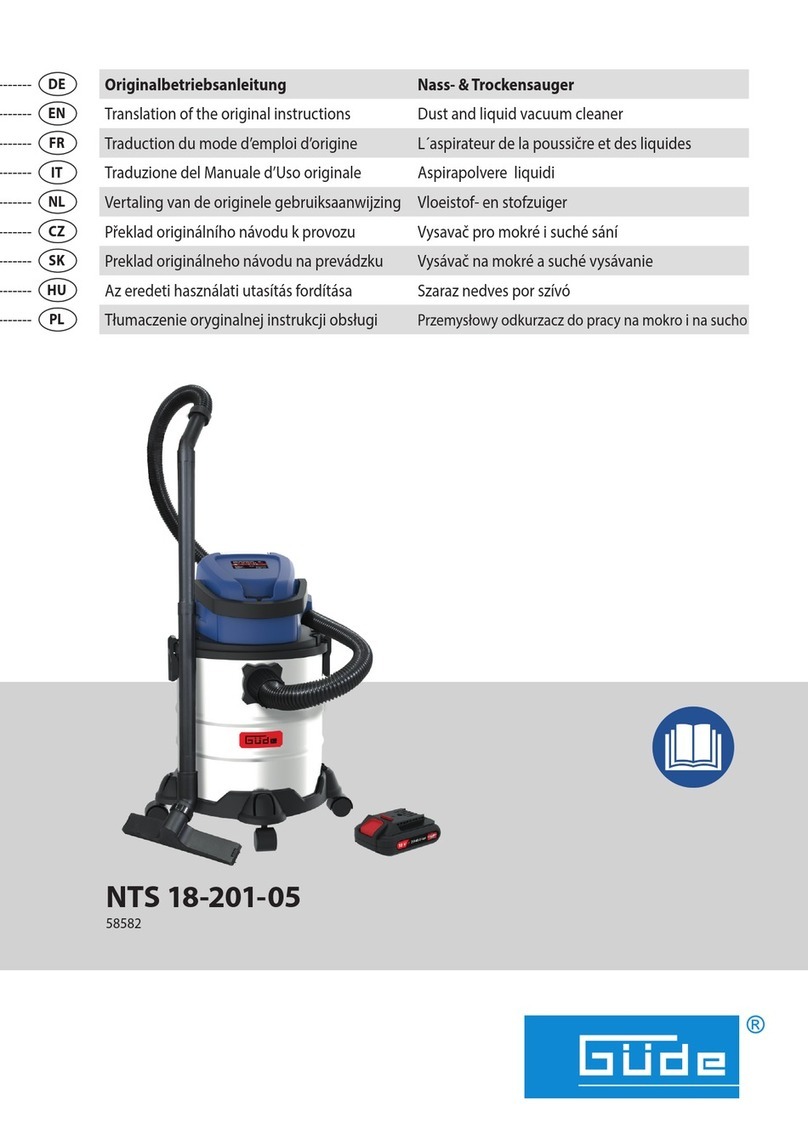
Gude
Gude NTS 18-201-05 User manual

Gude
Gude GAA 65.1 User manual
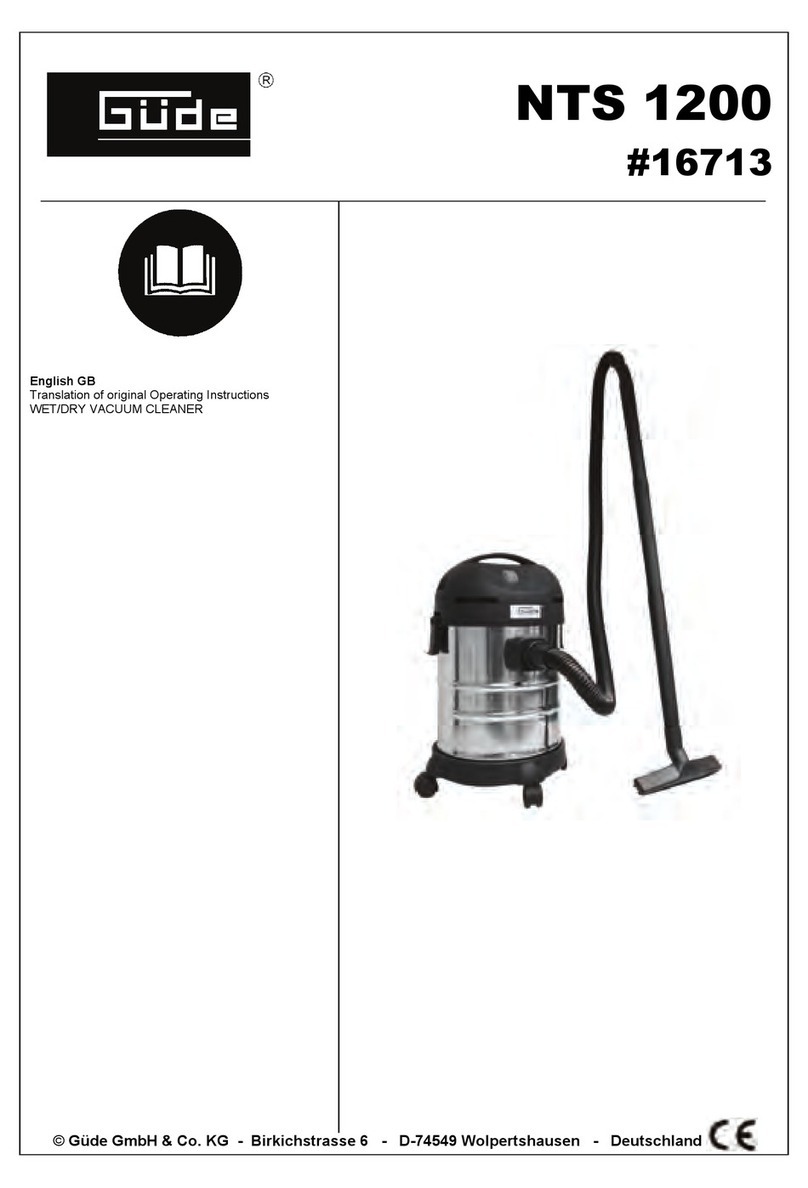
Gude
Gude NTS 1200 User manual
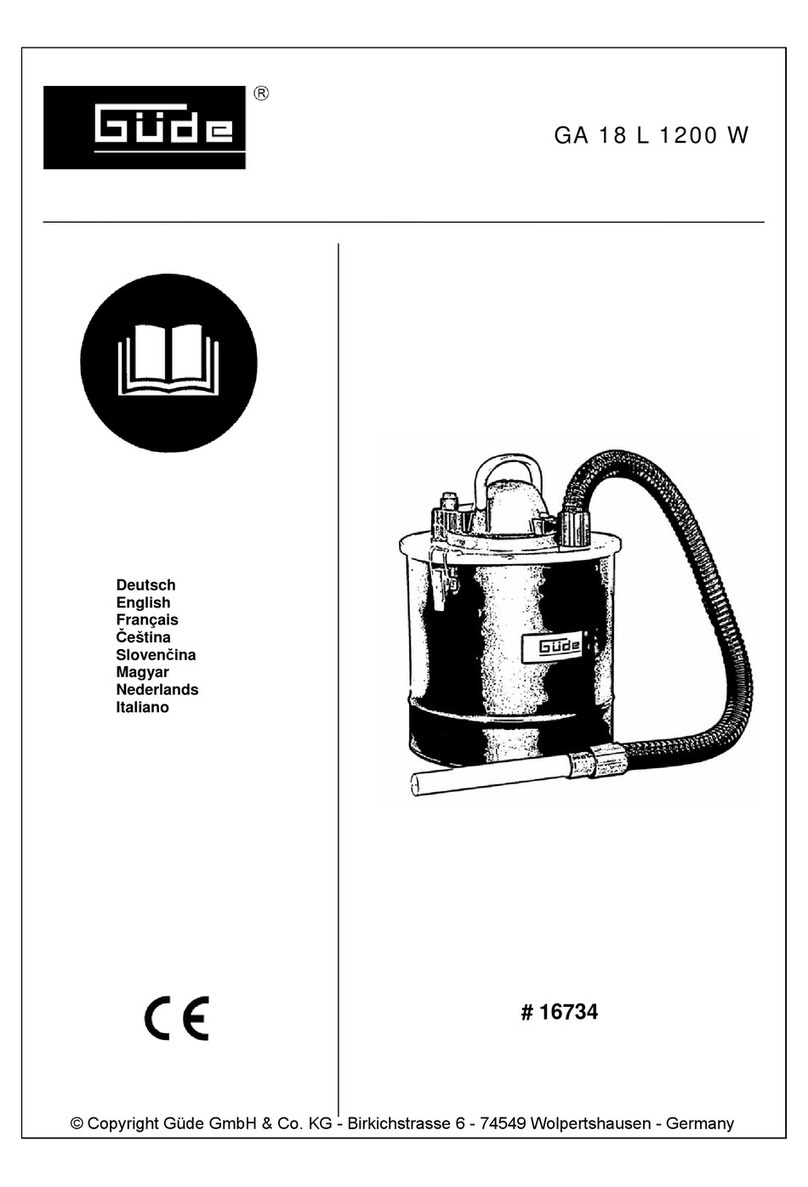
Gude
Gude GA 18 L 1200 W User manual
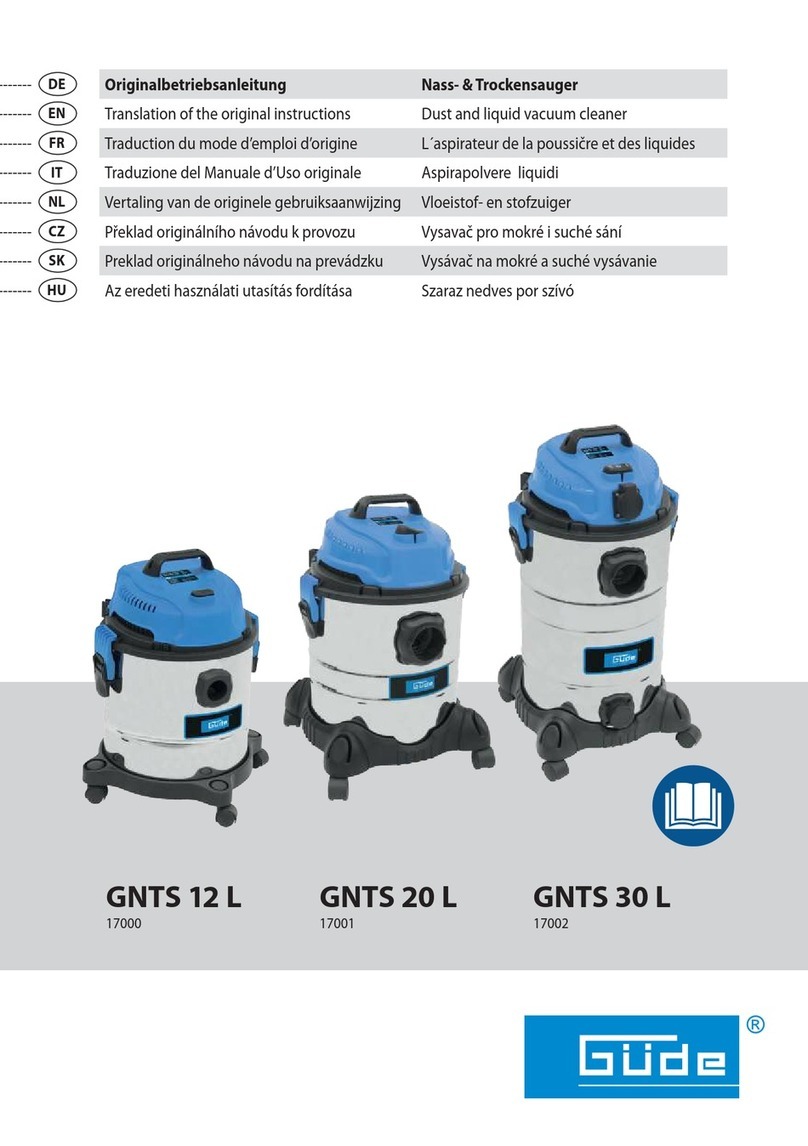
Gude
Gude GNTS 12 L User manual
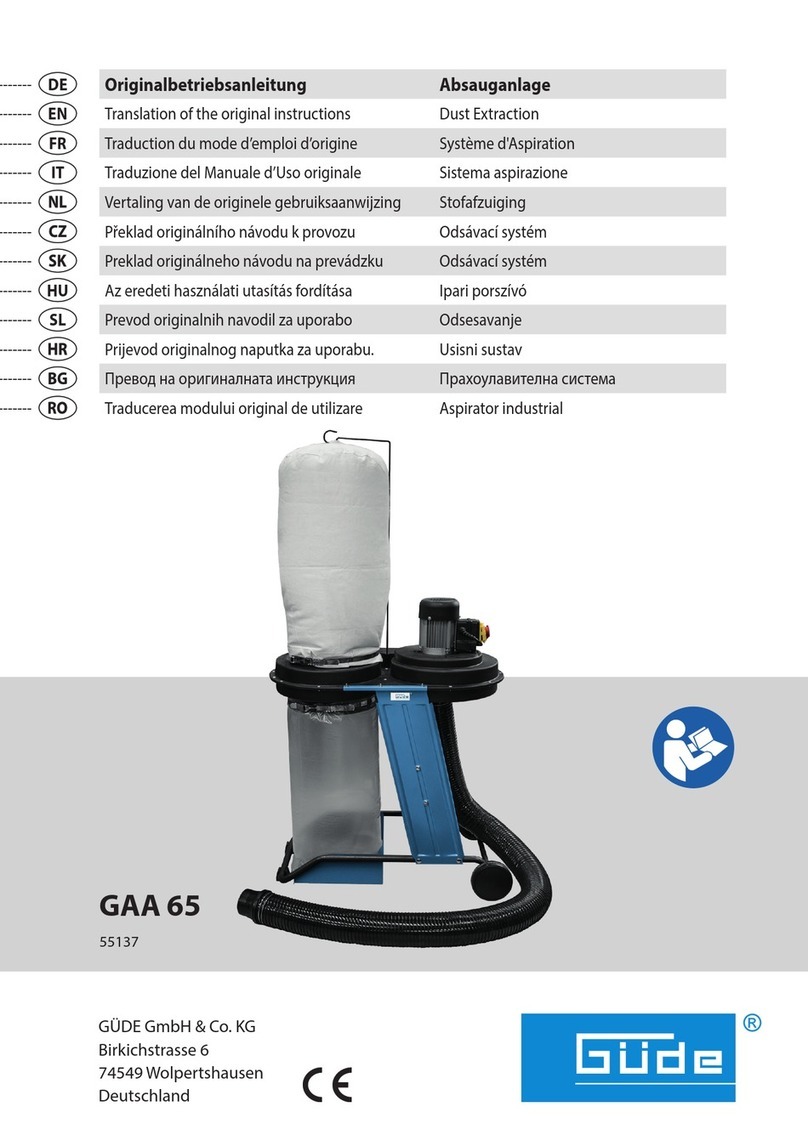
Gude
Gude GAA 65 User manual
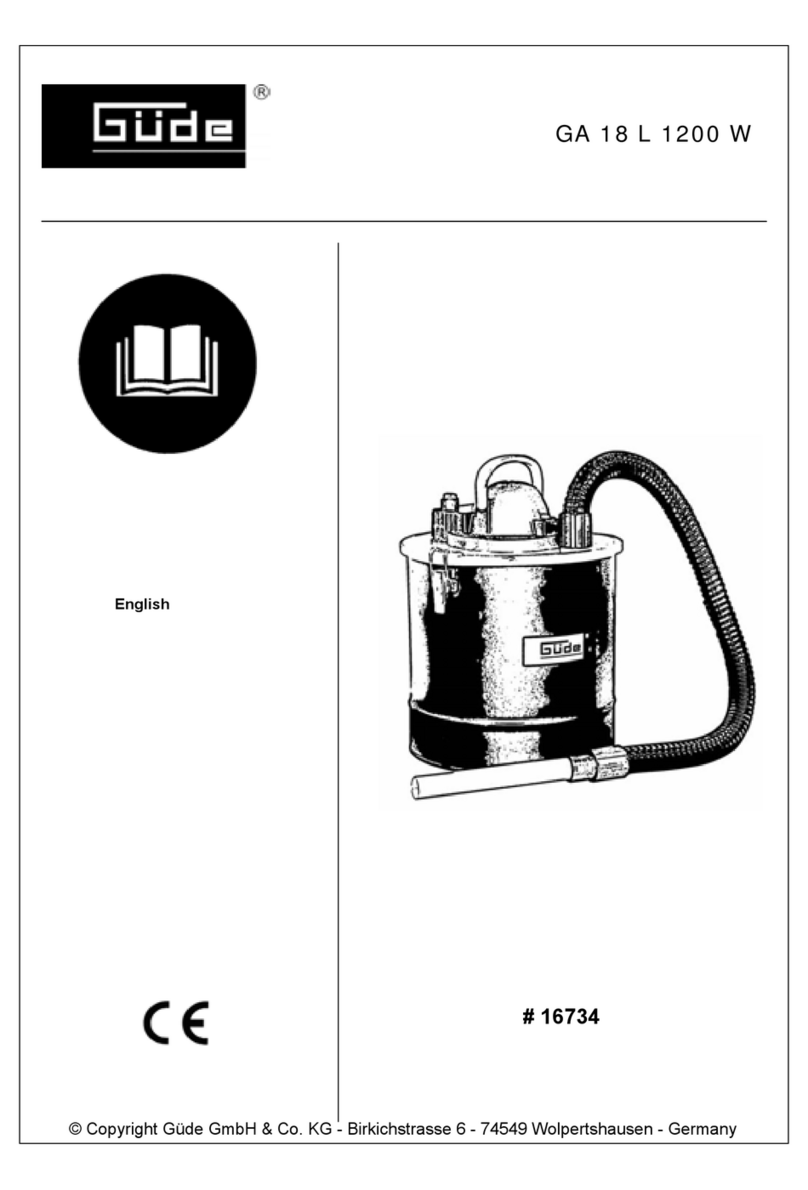
Gude
Gude GA 18 L 1200 W User manual

Gude
Gude GAA 50 User manual
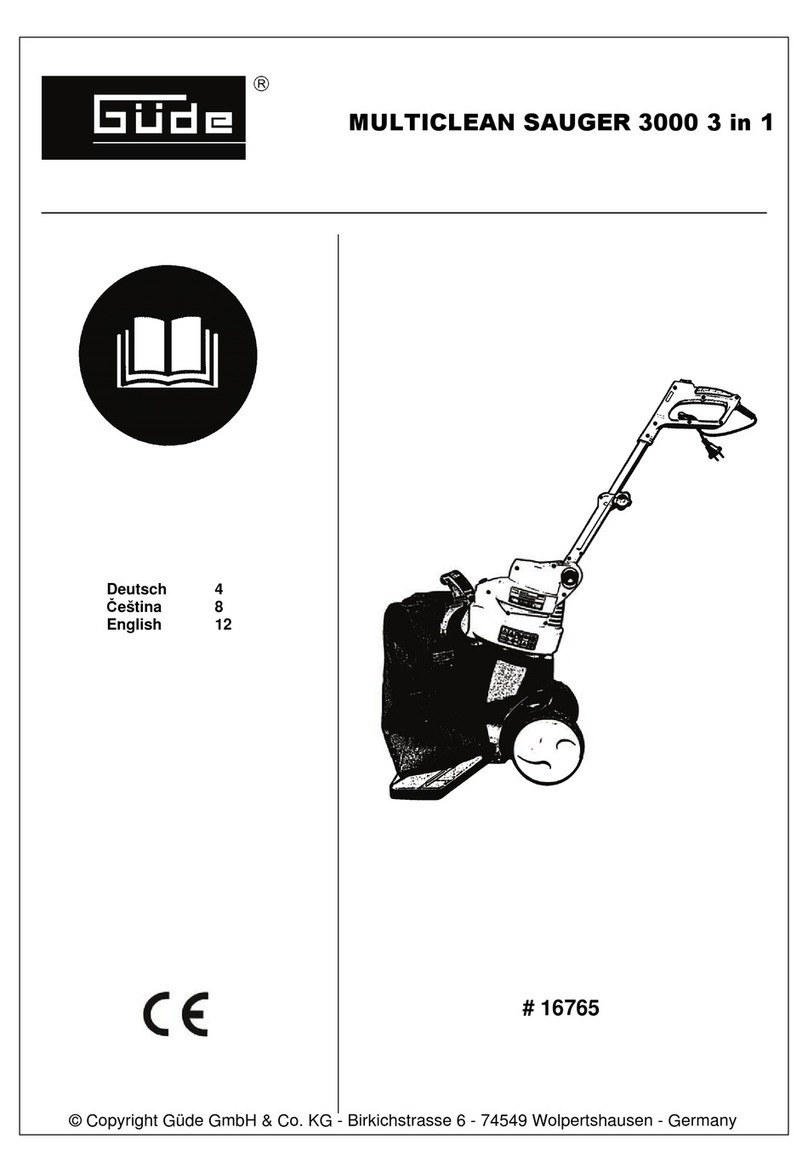
Gude
Gude MULTICLEAN 3000 3 in 1 User manual
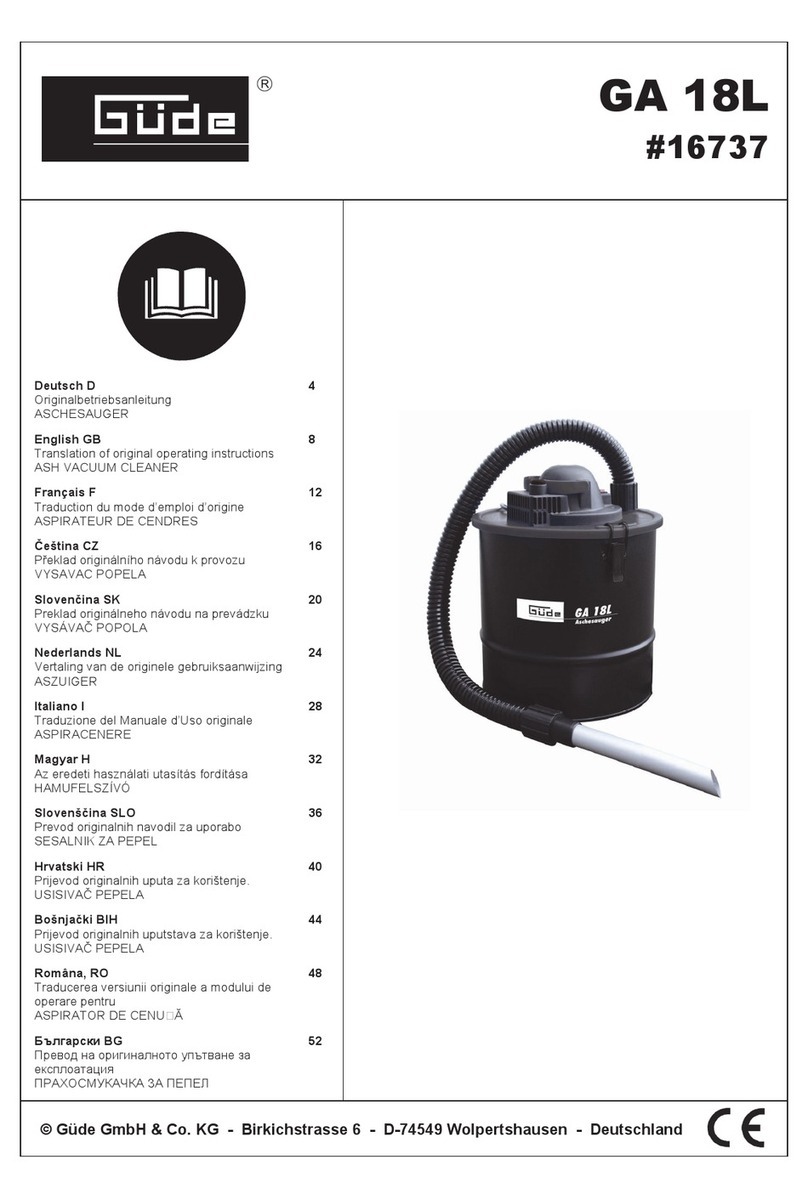
Gude
Gude GA 18L Wiring diagram
